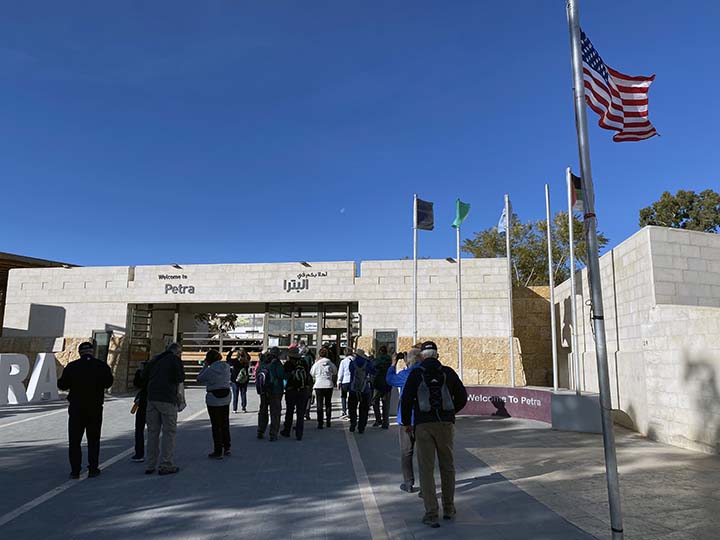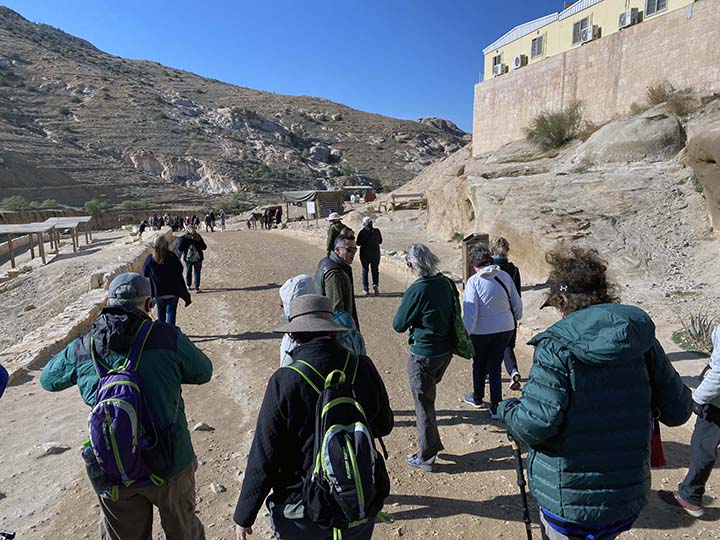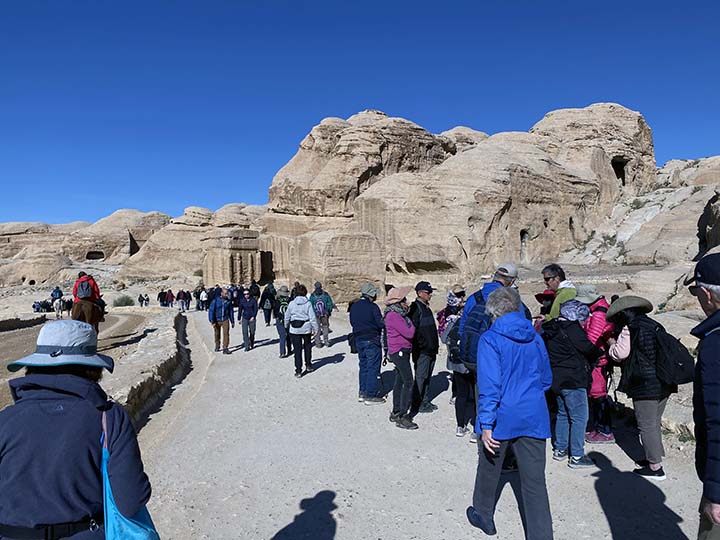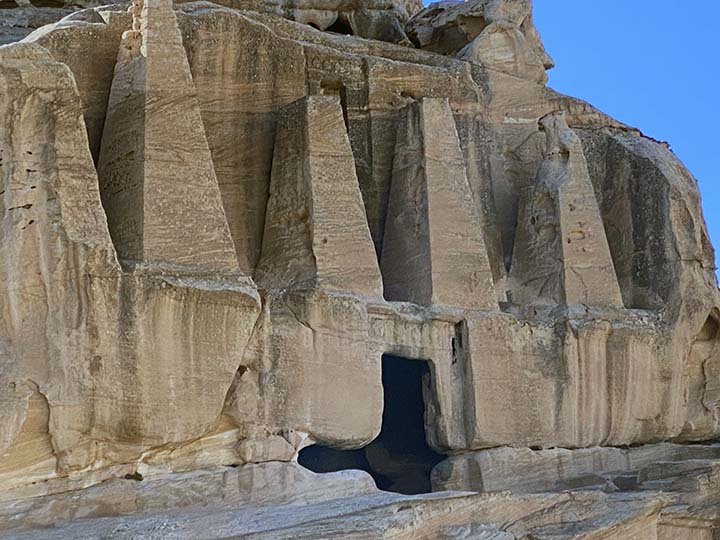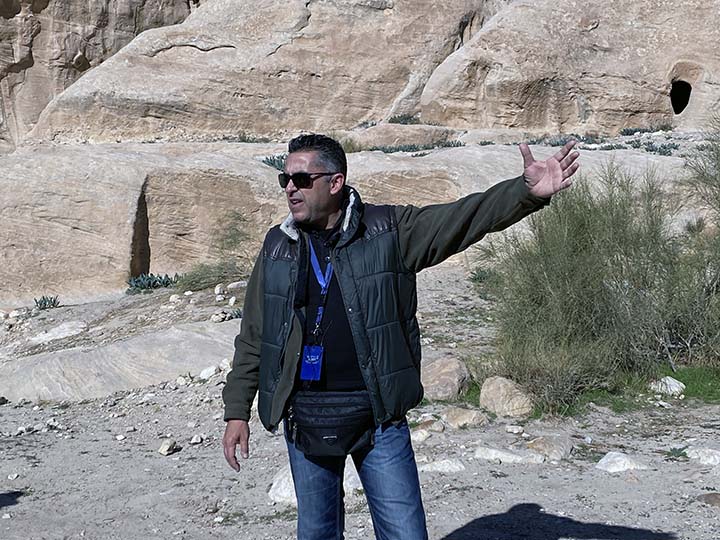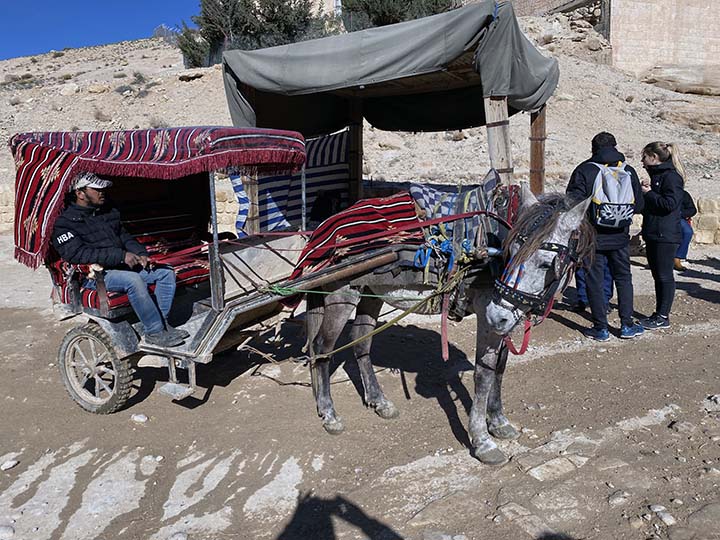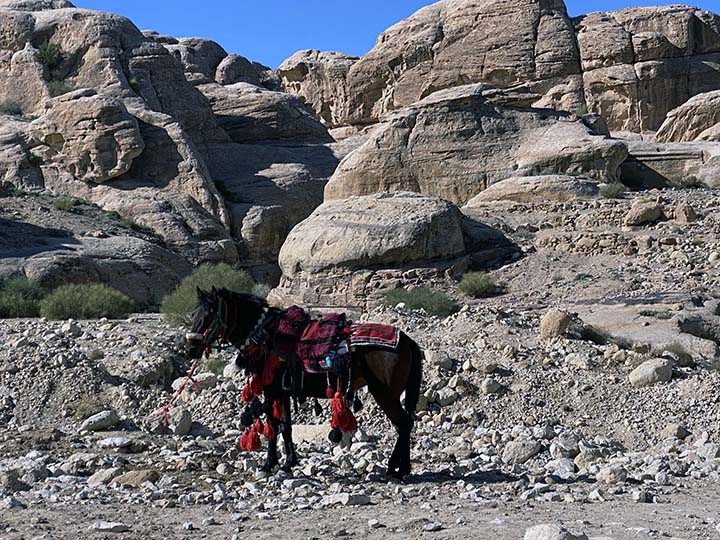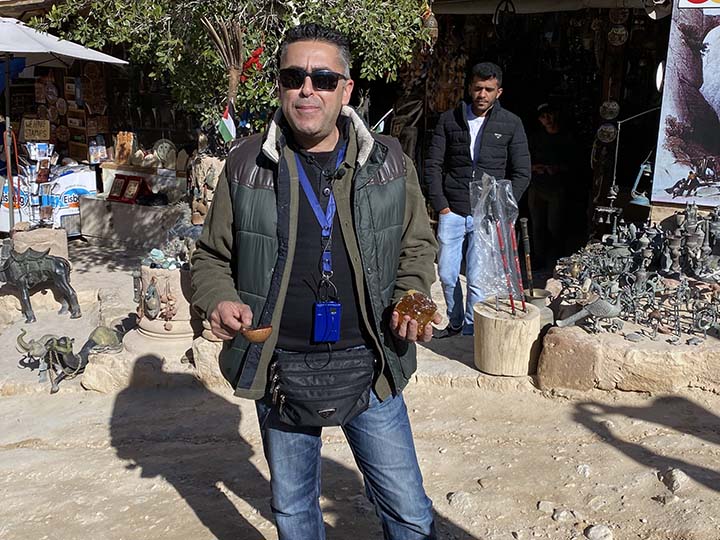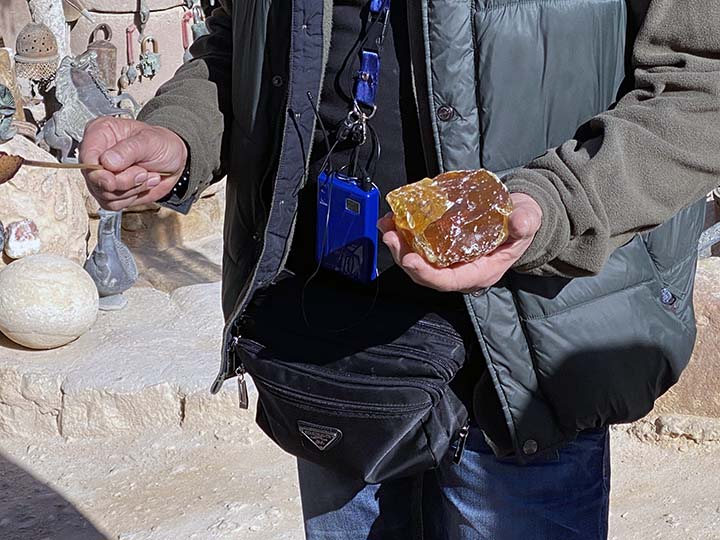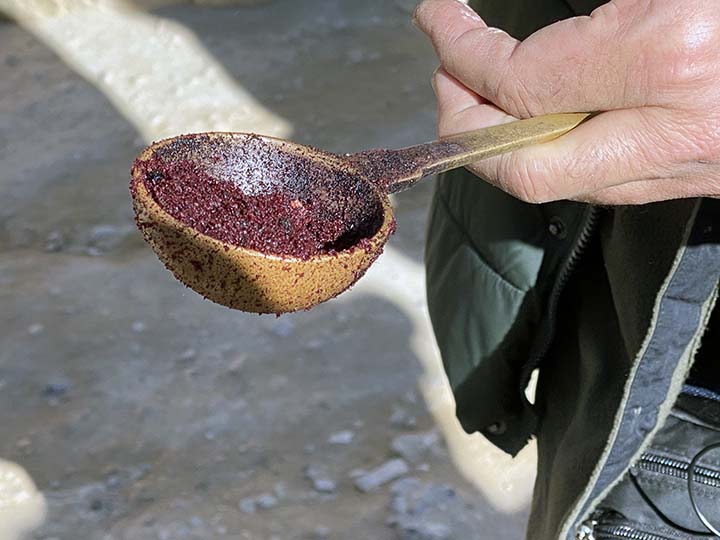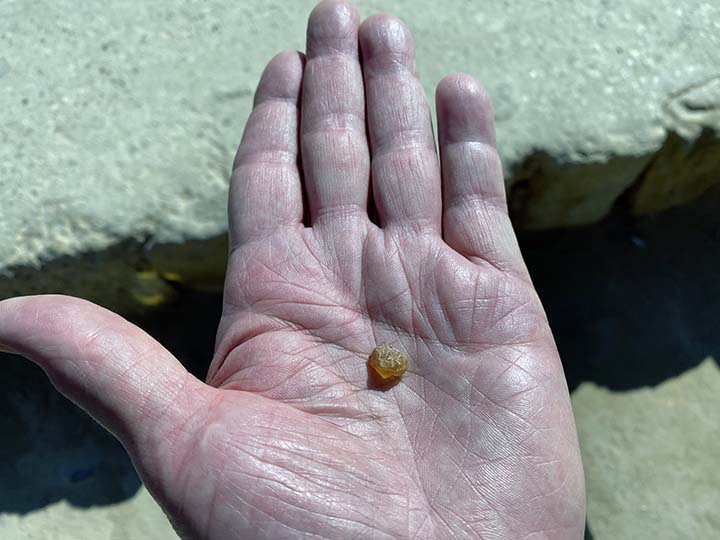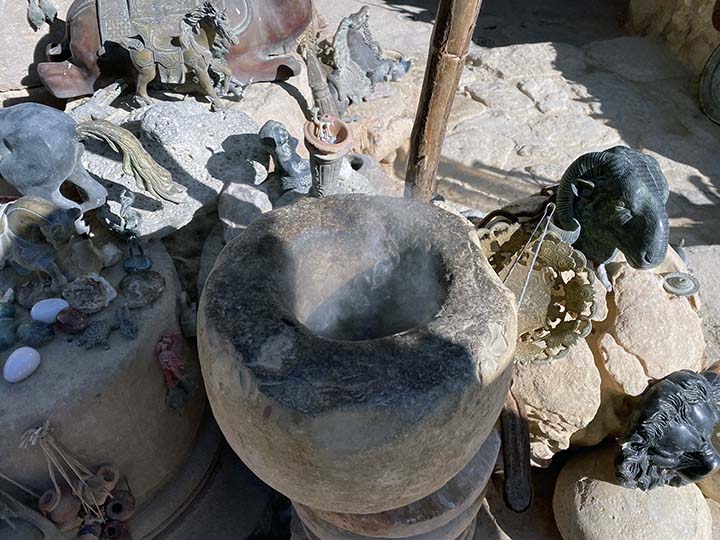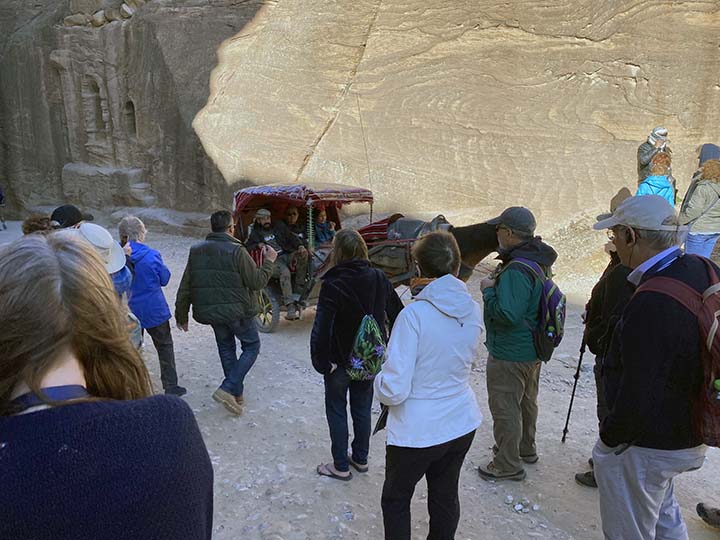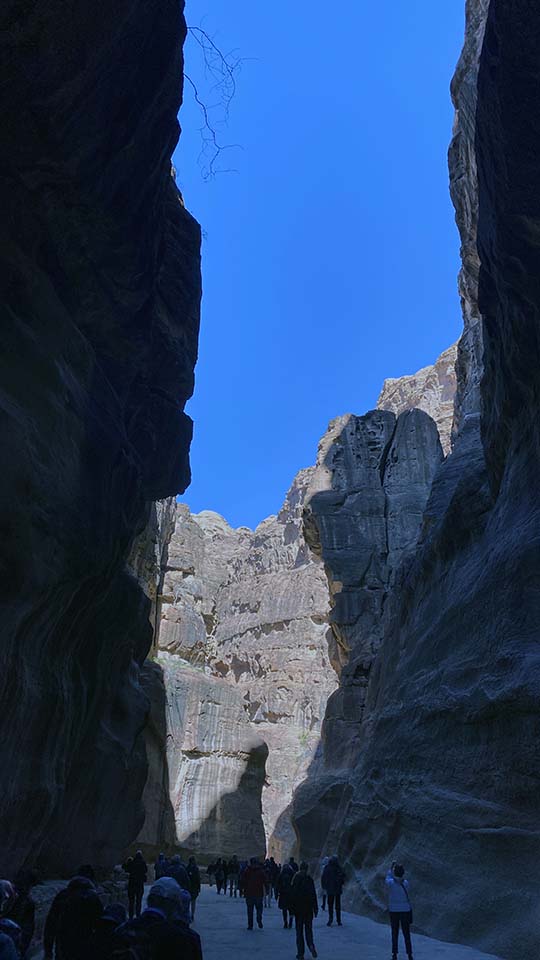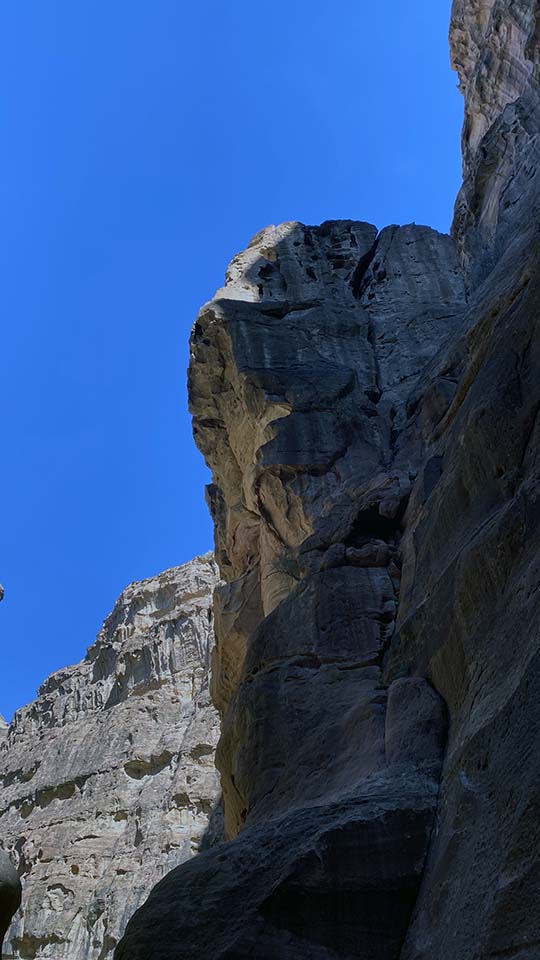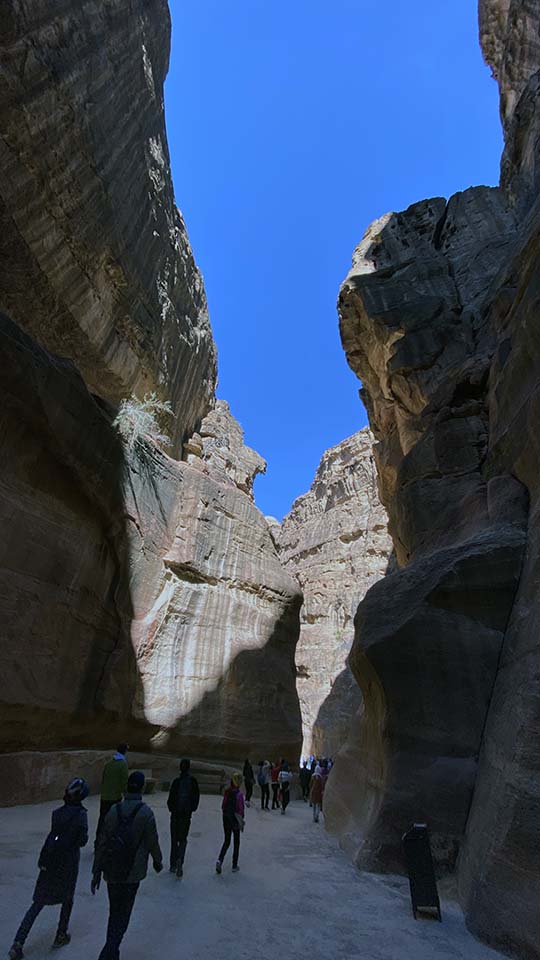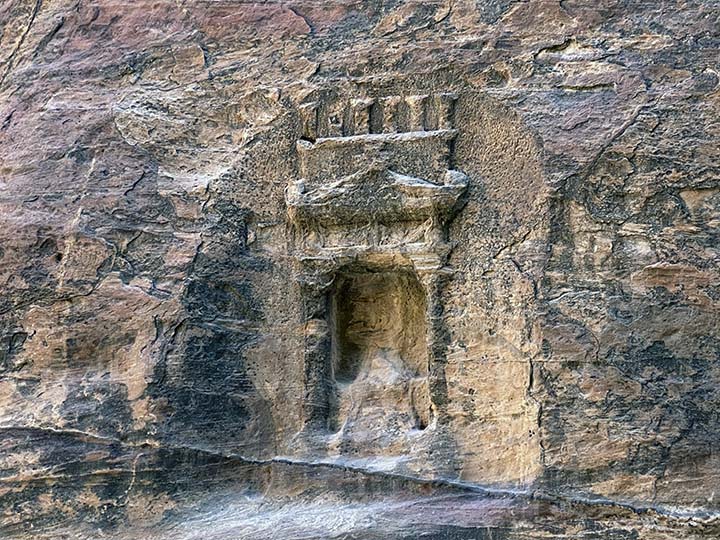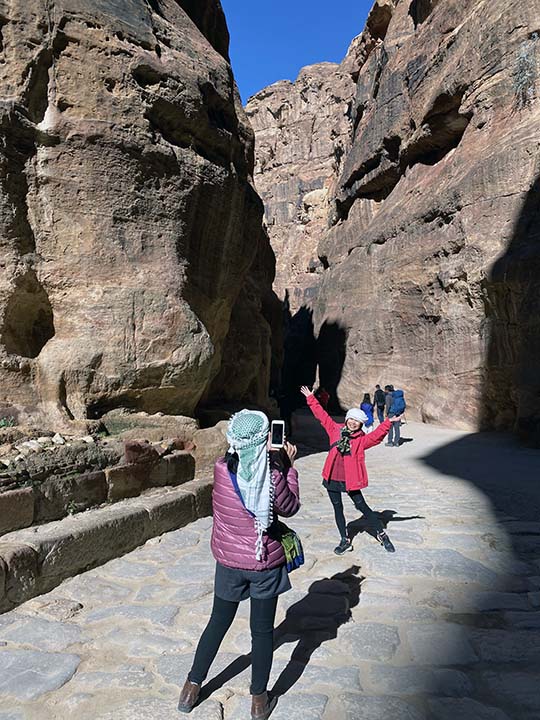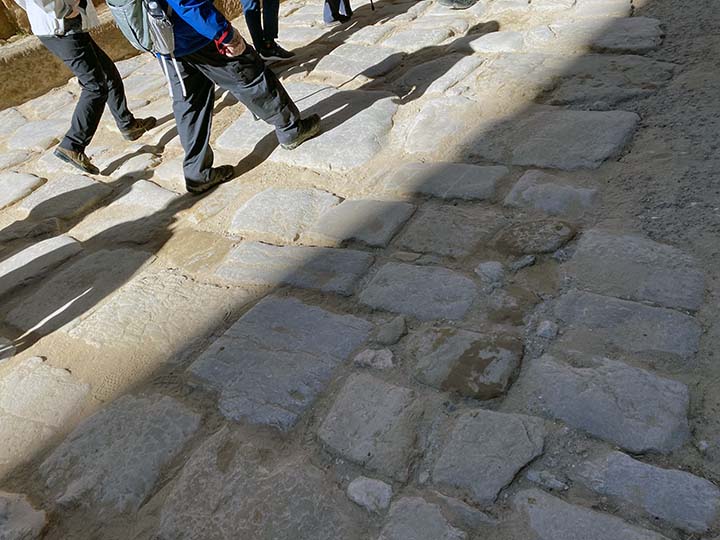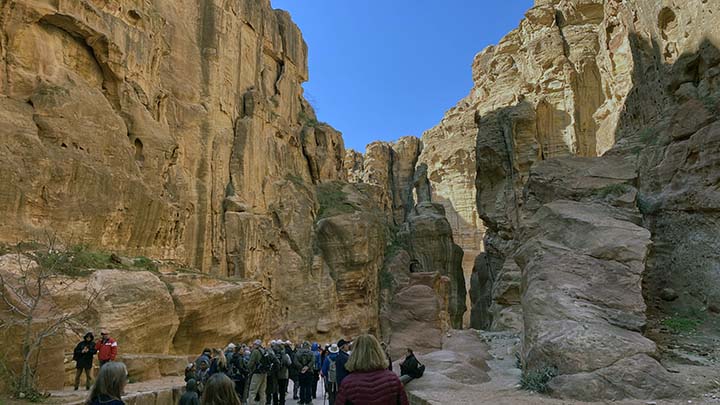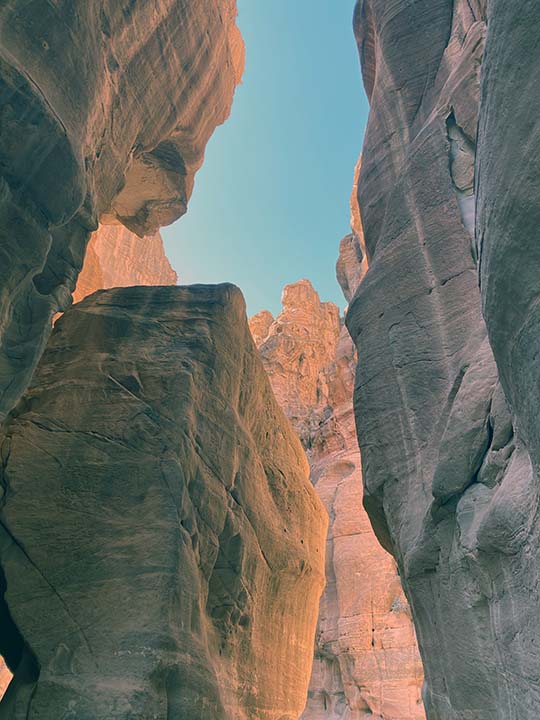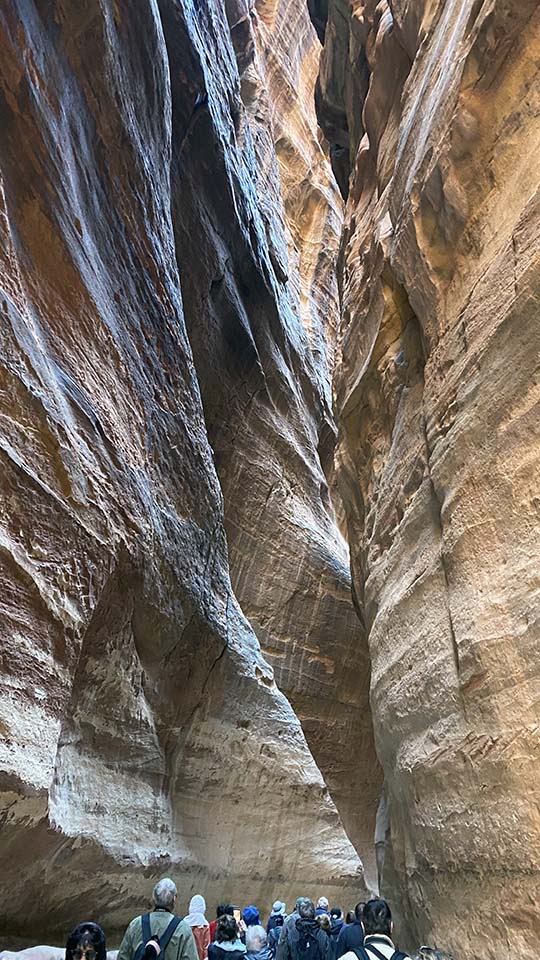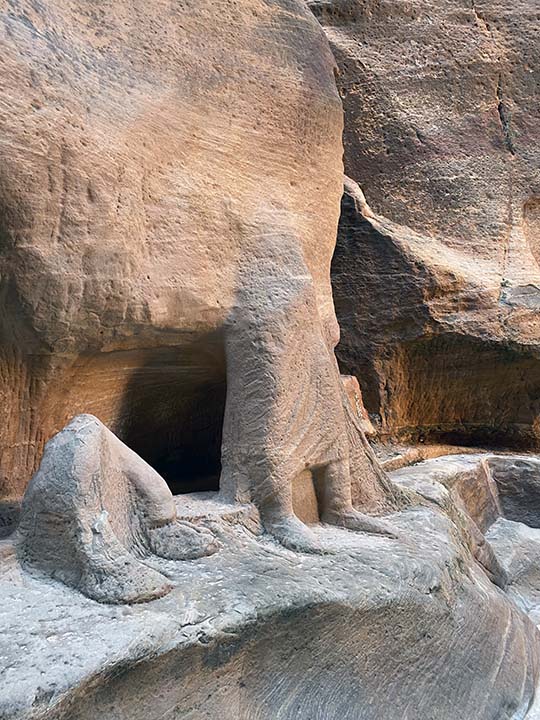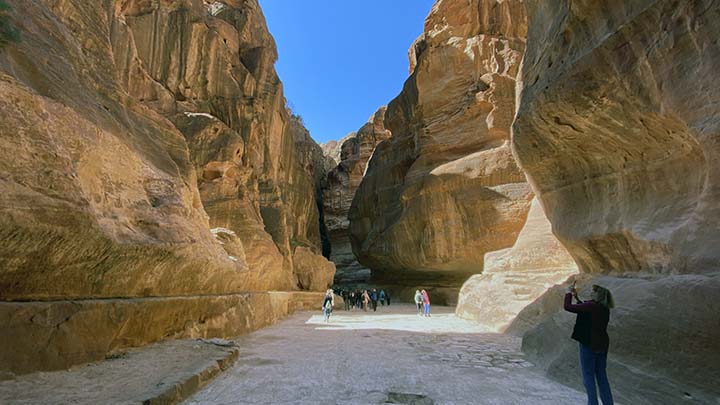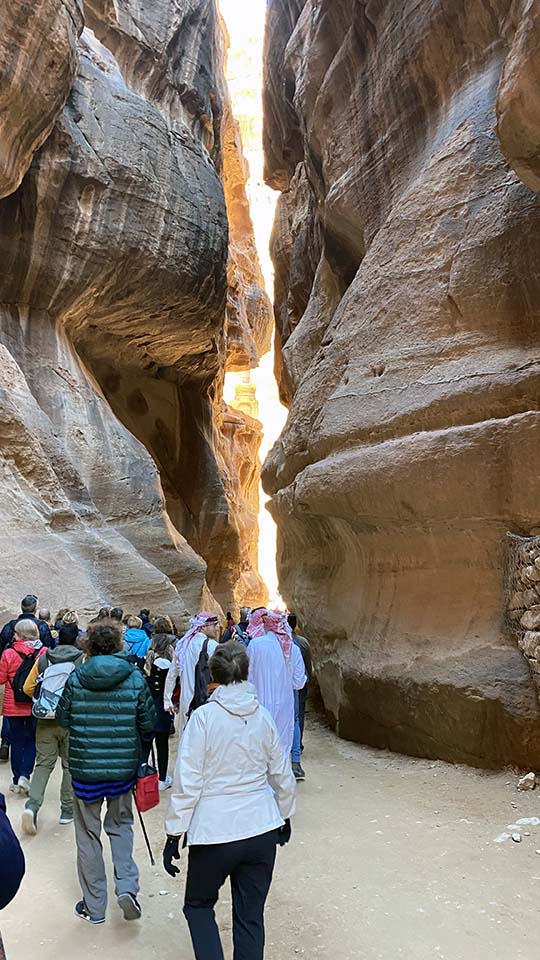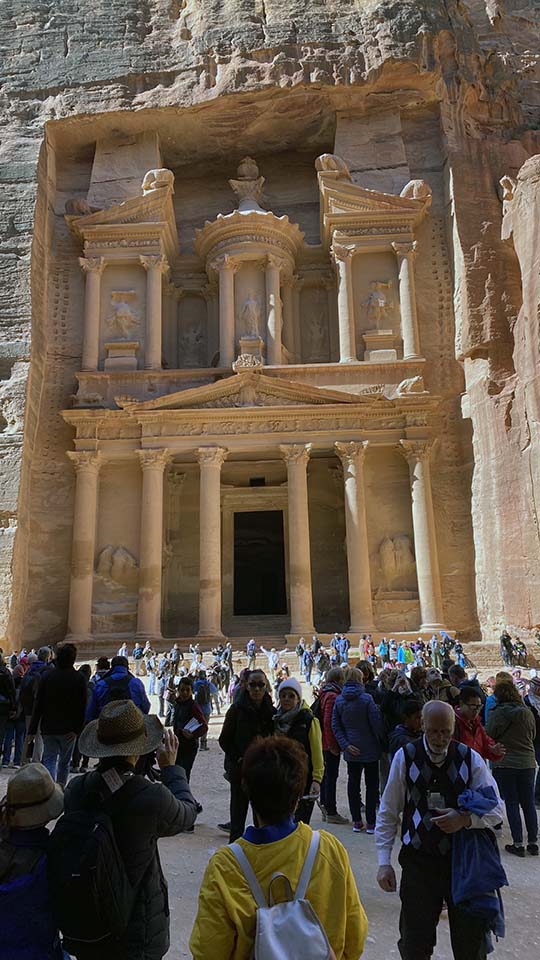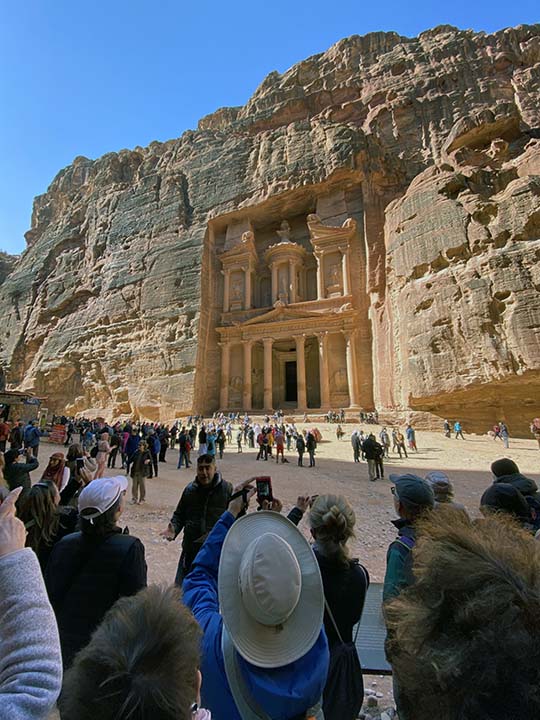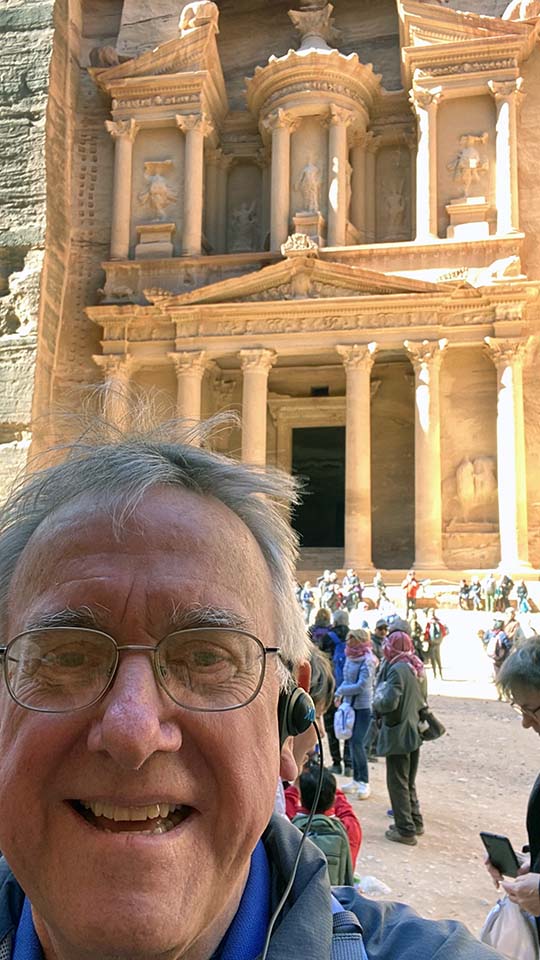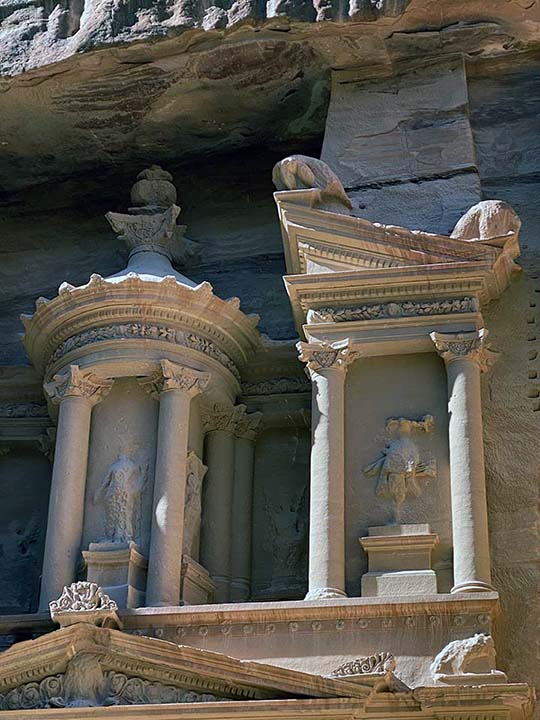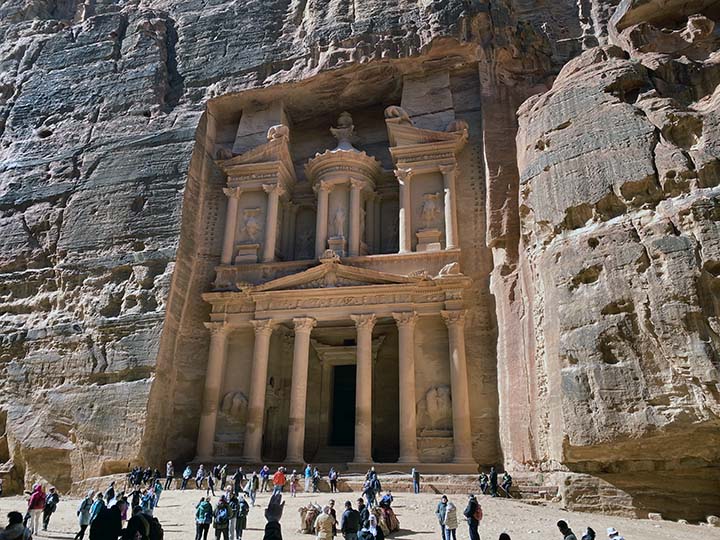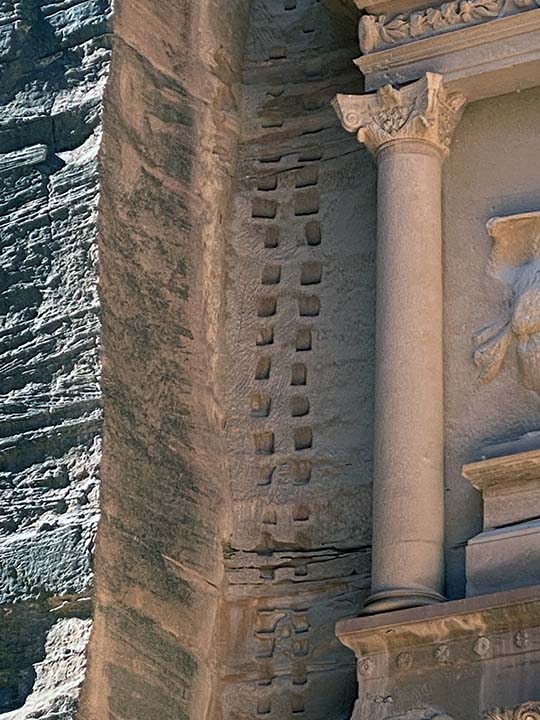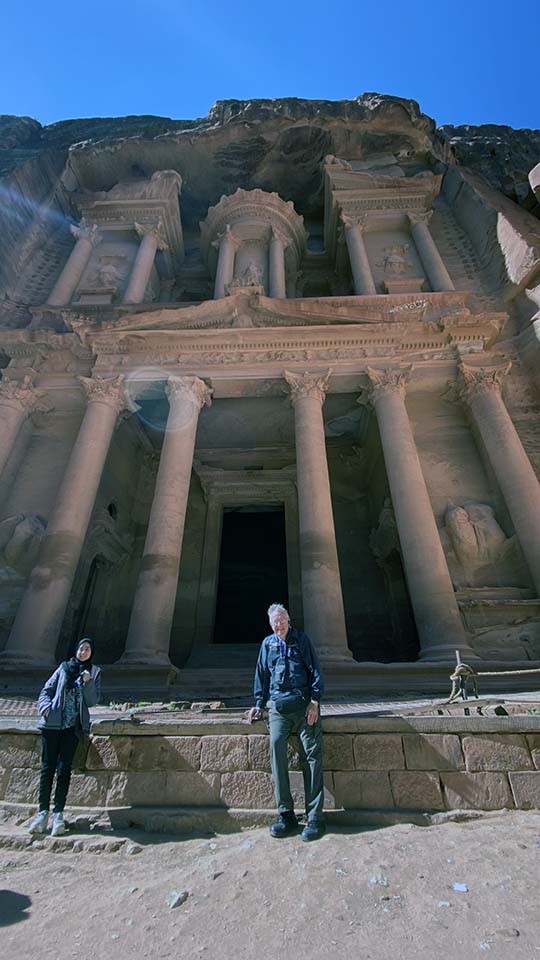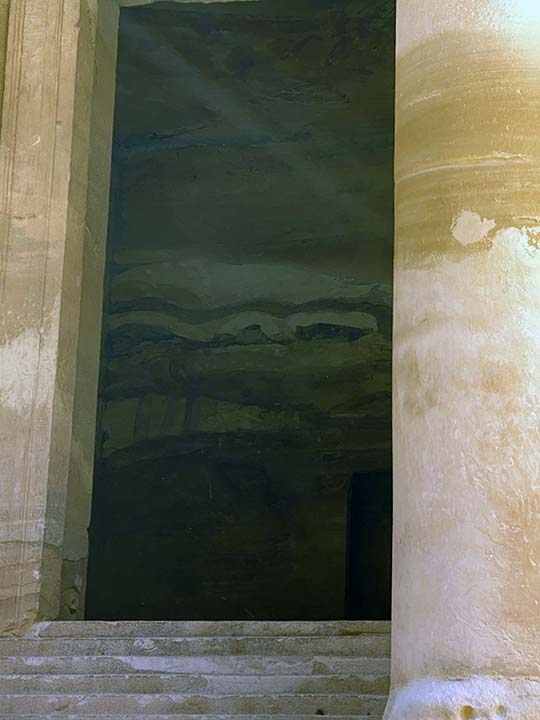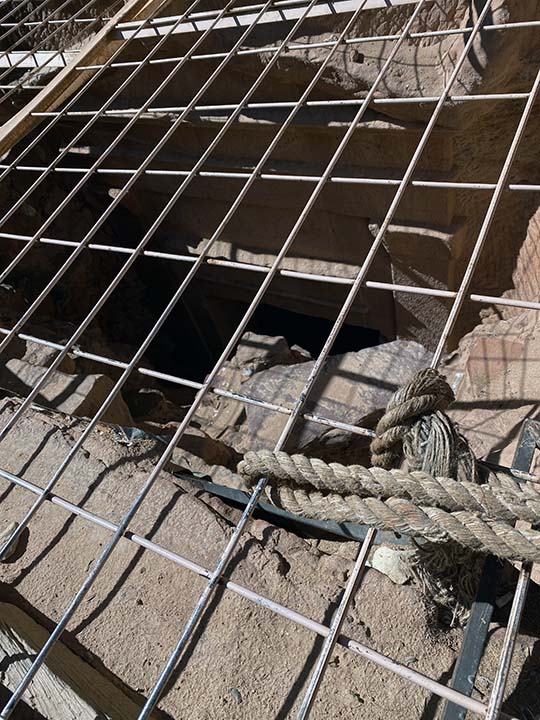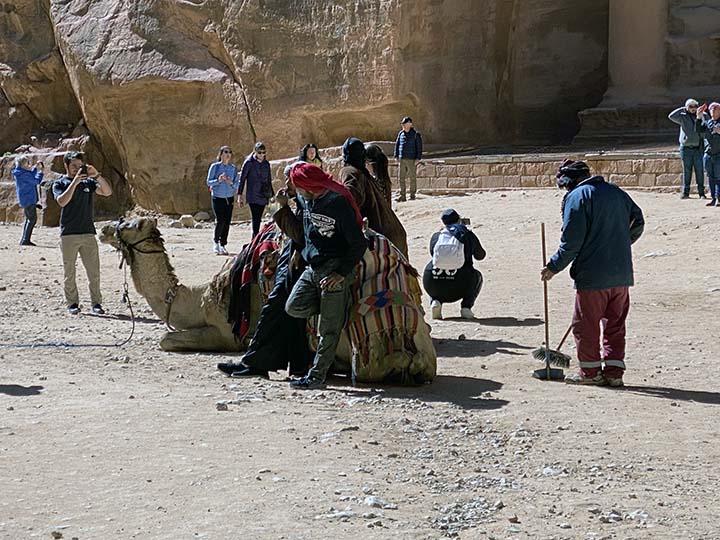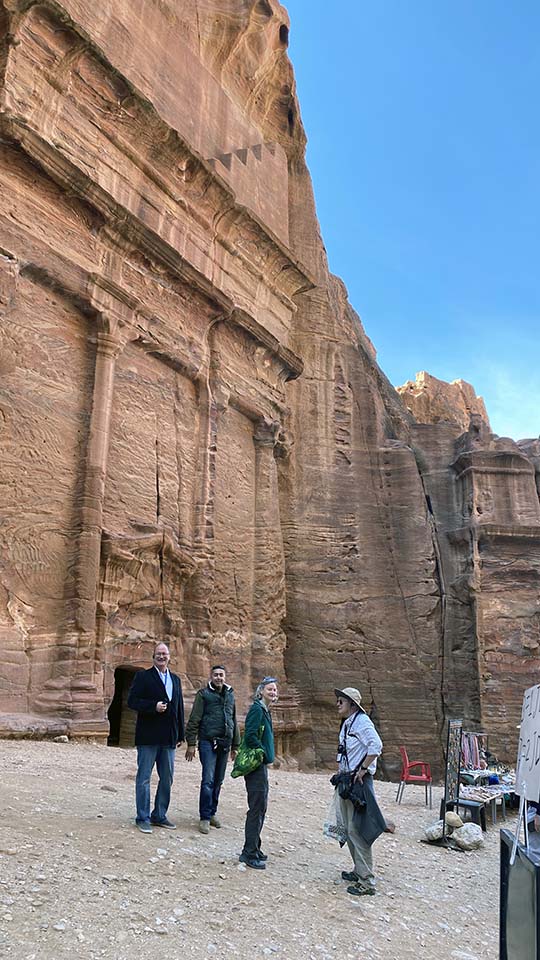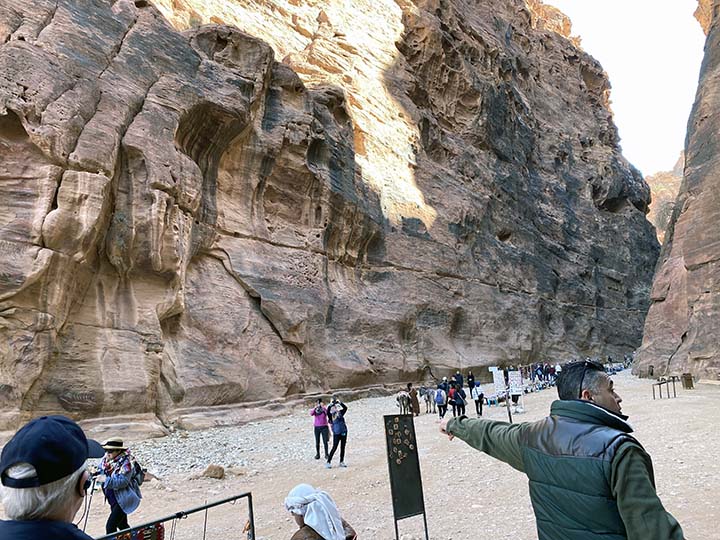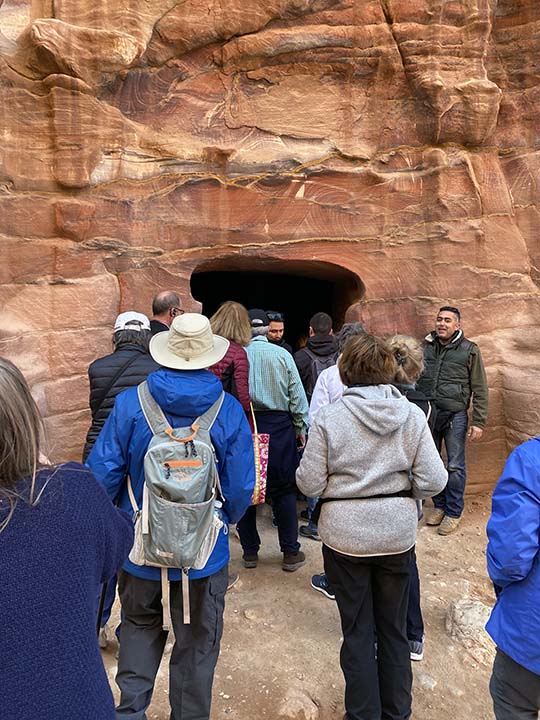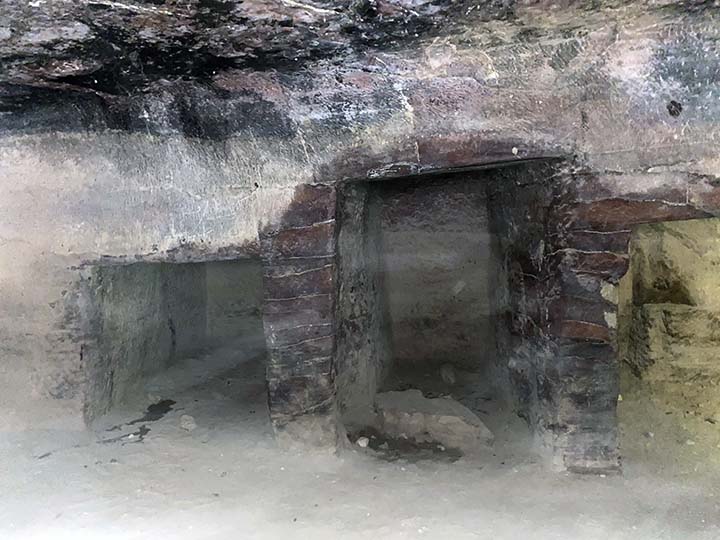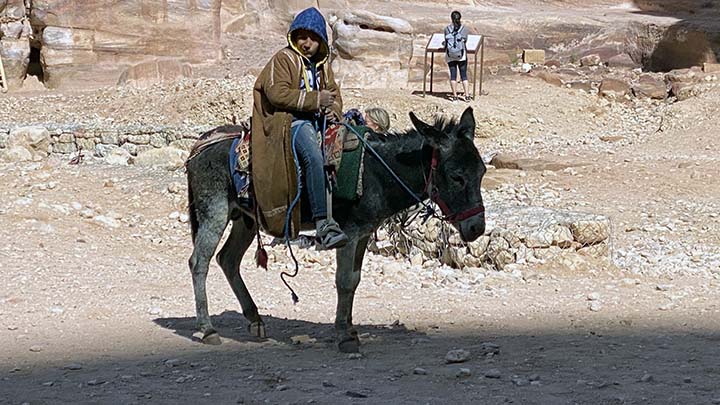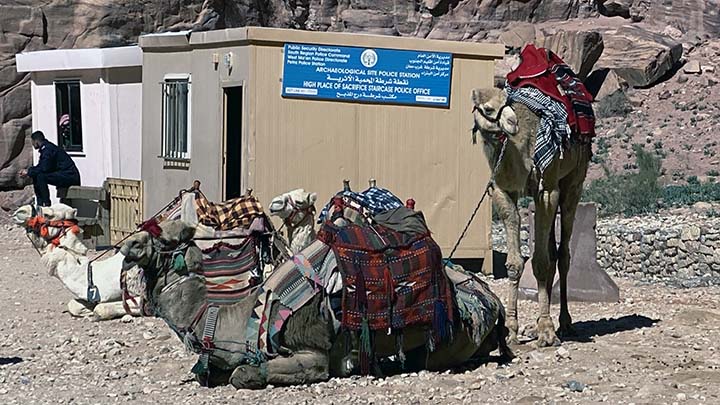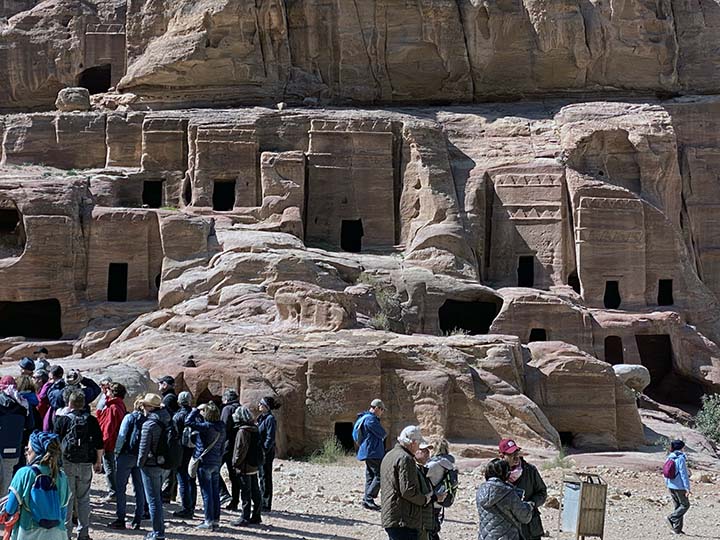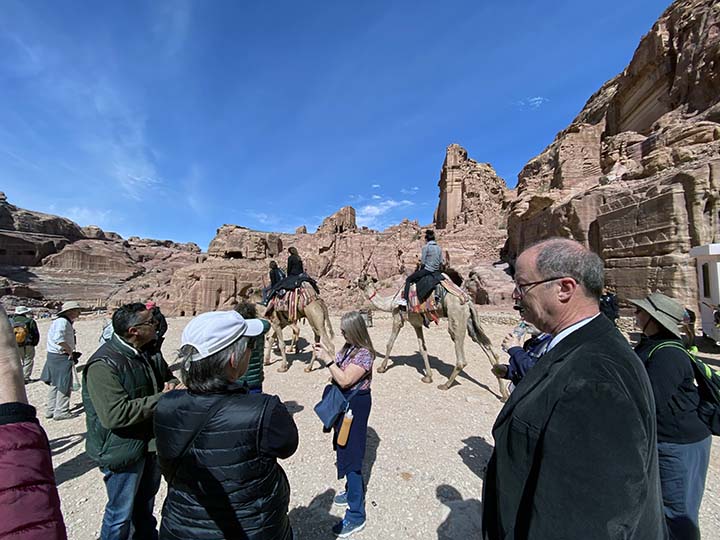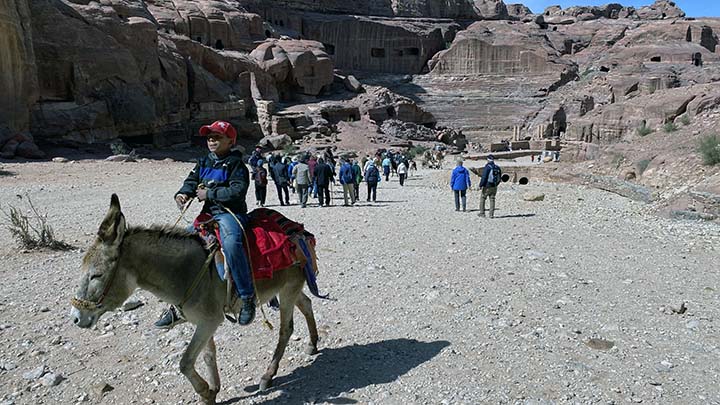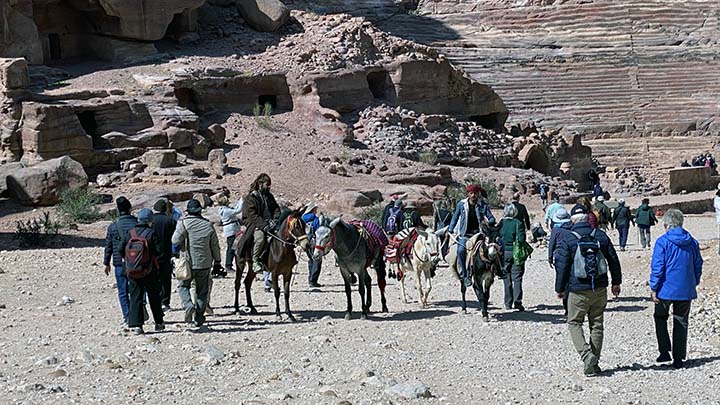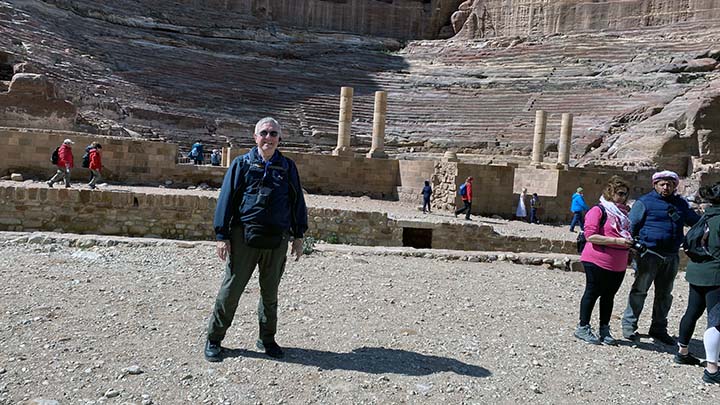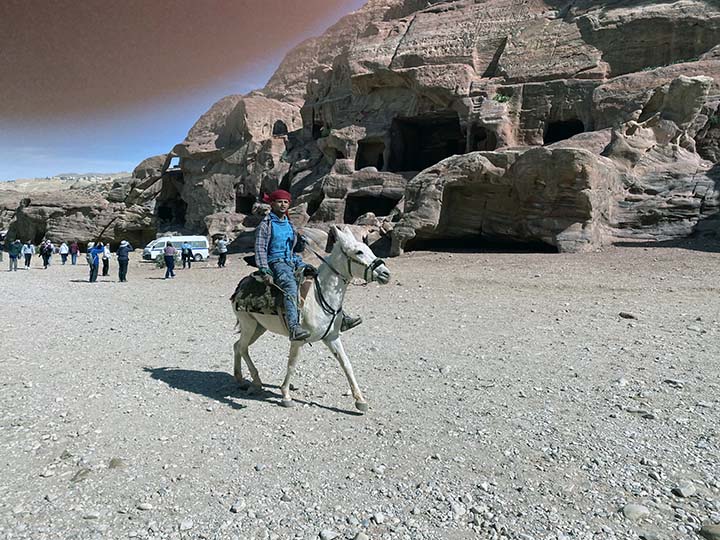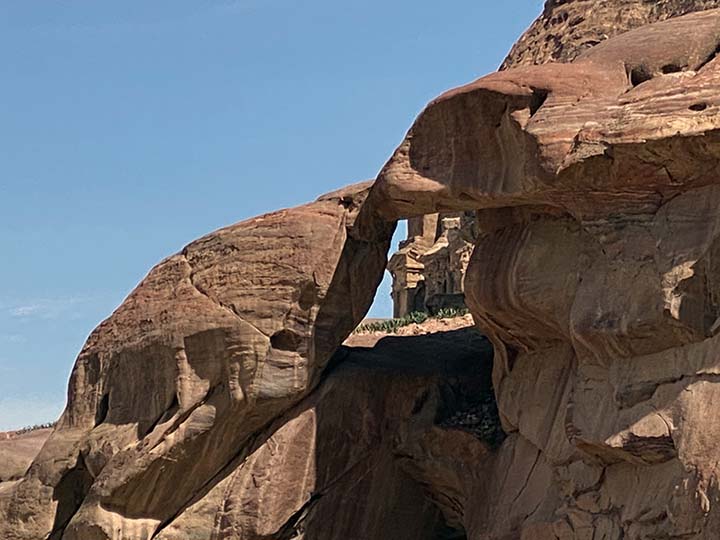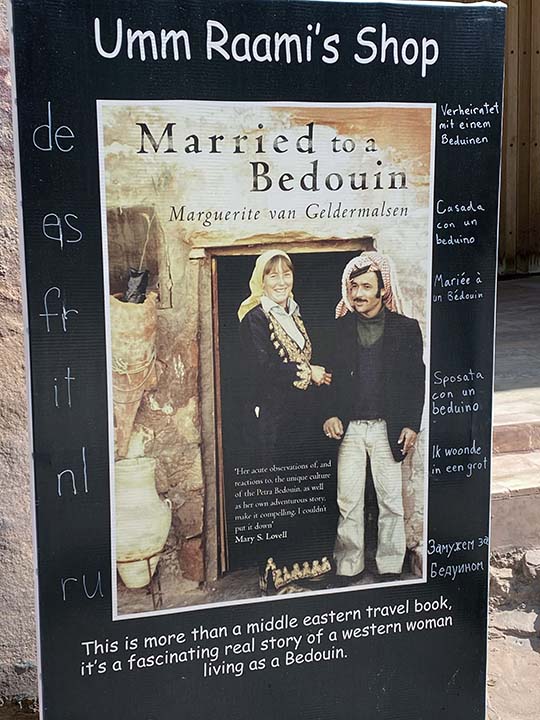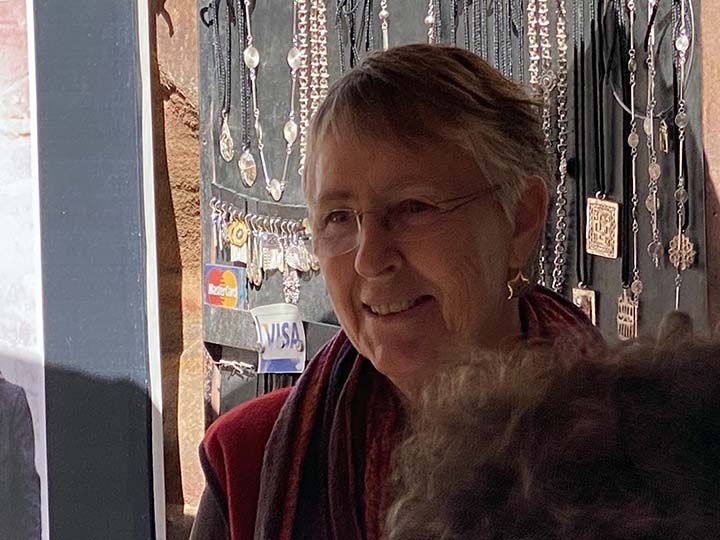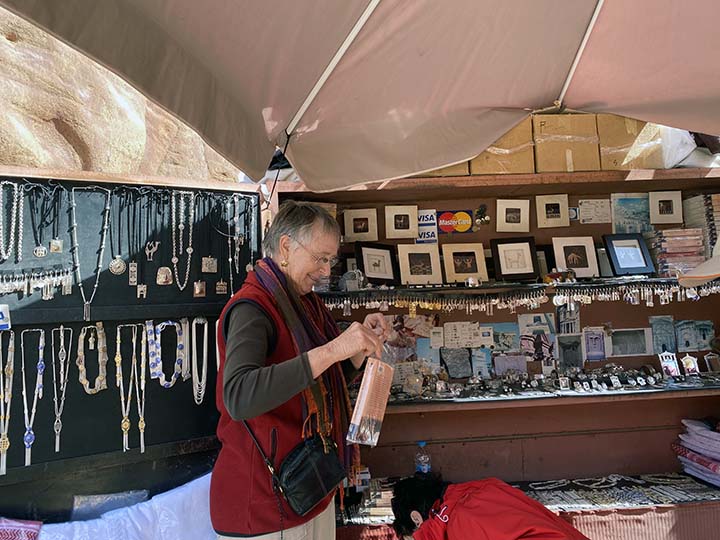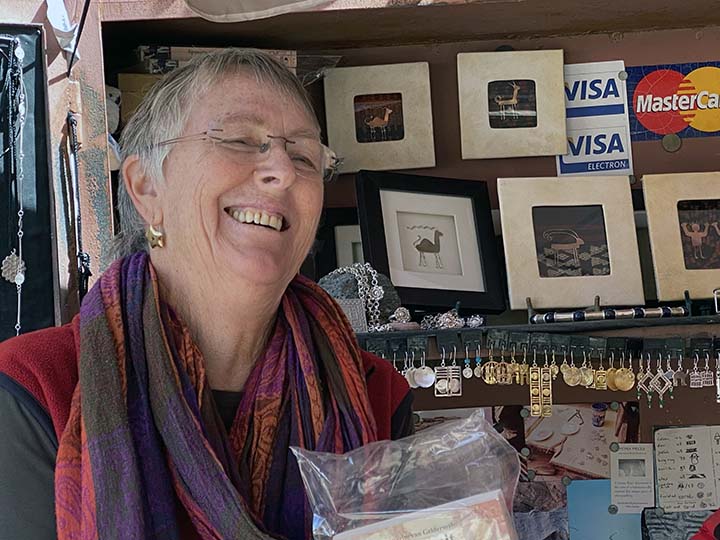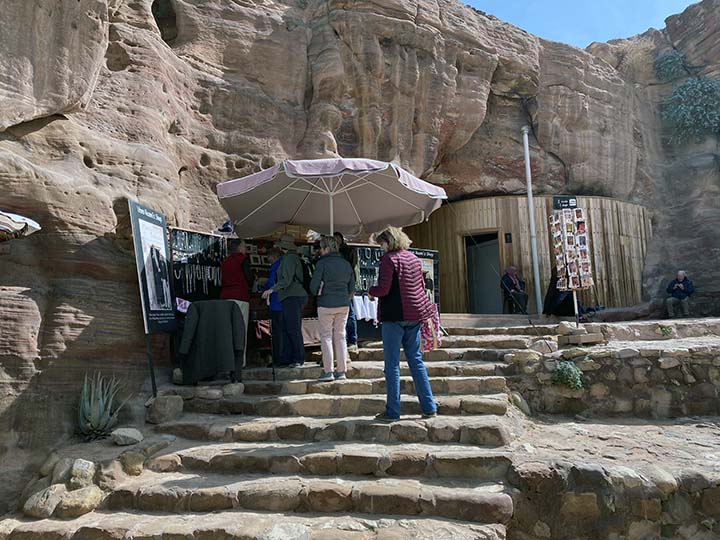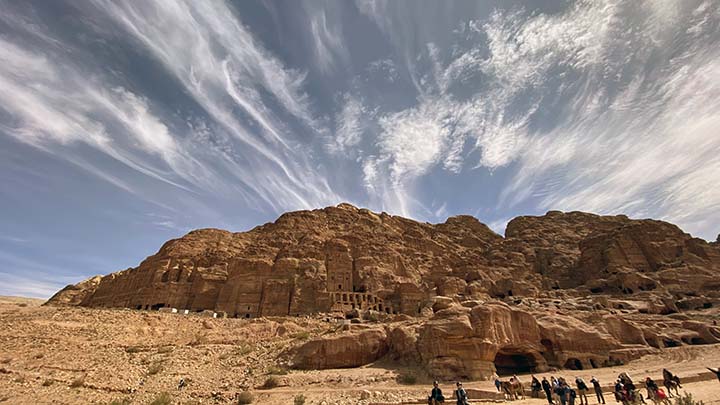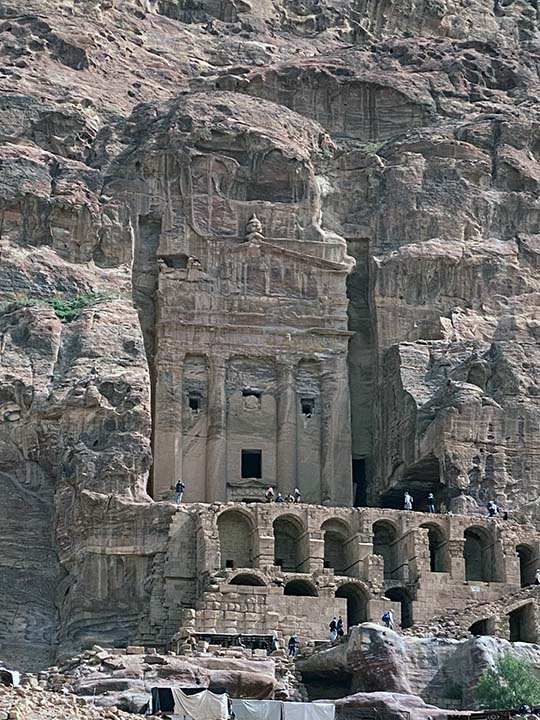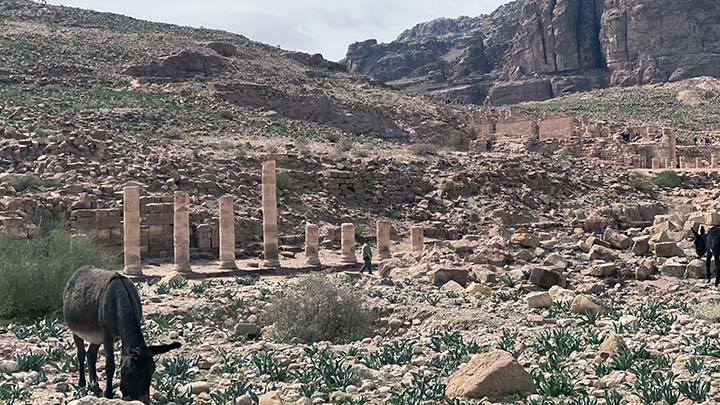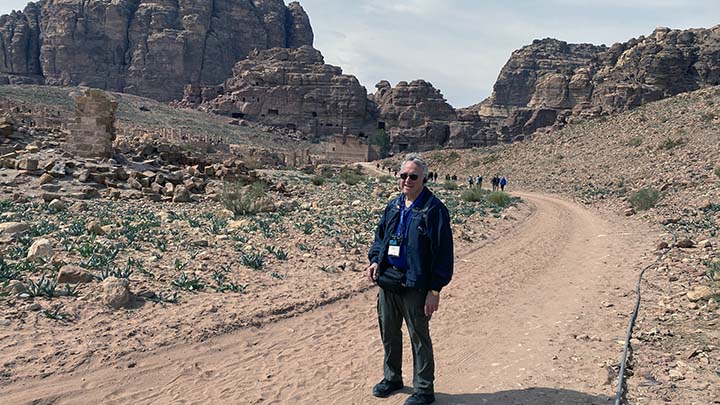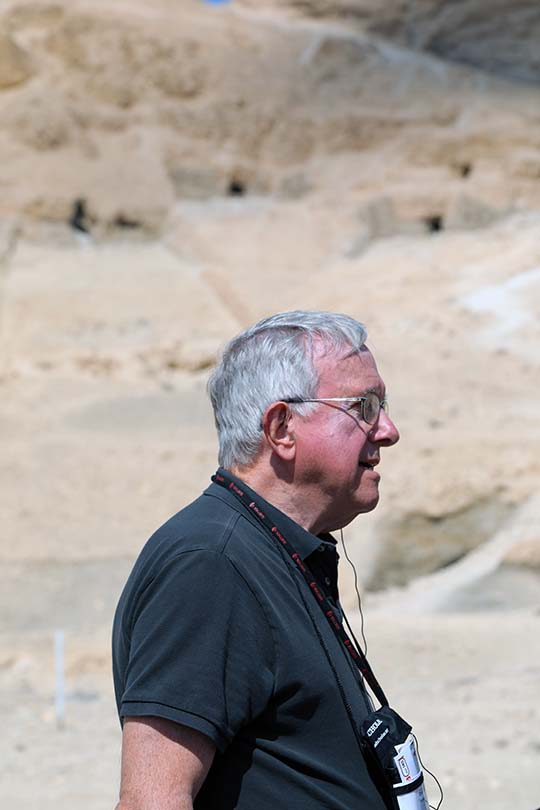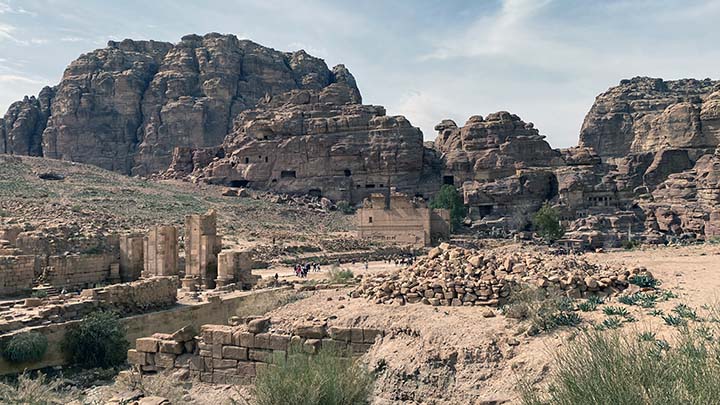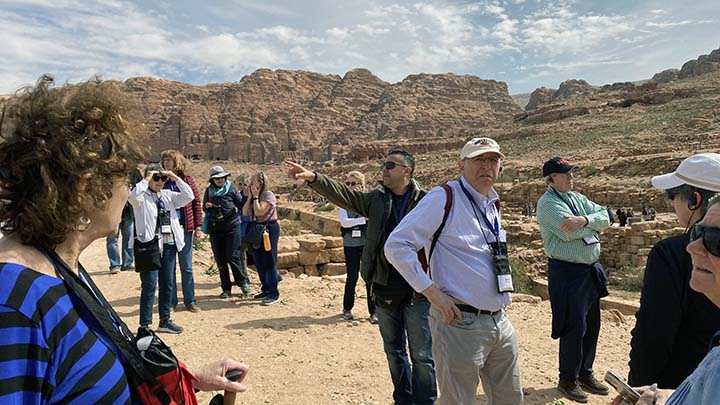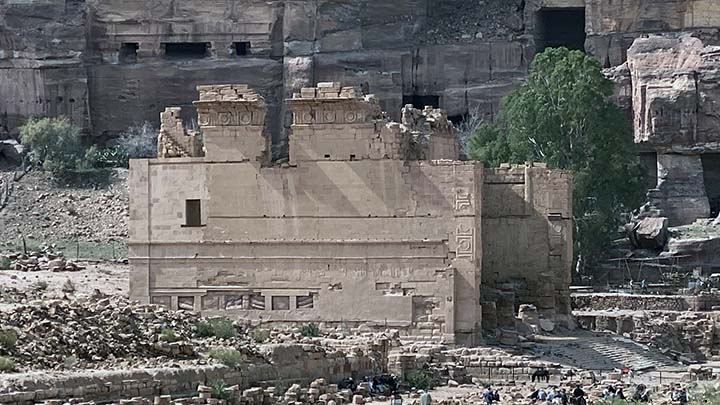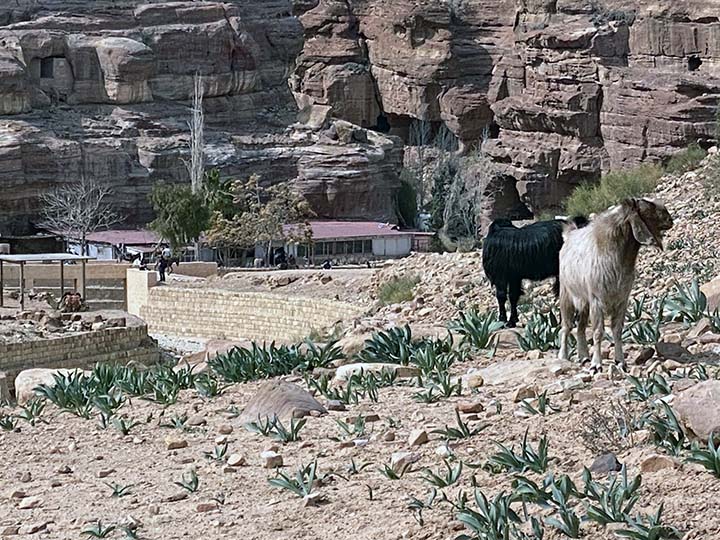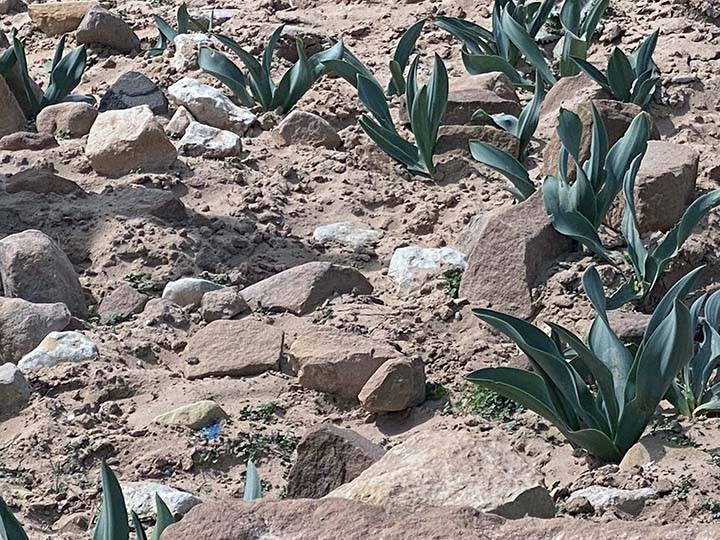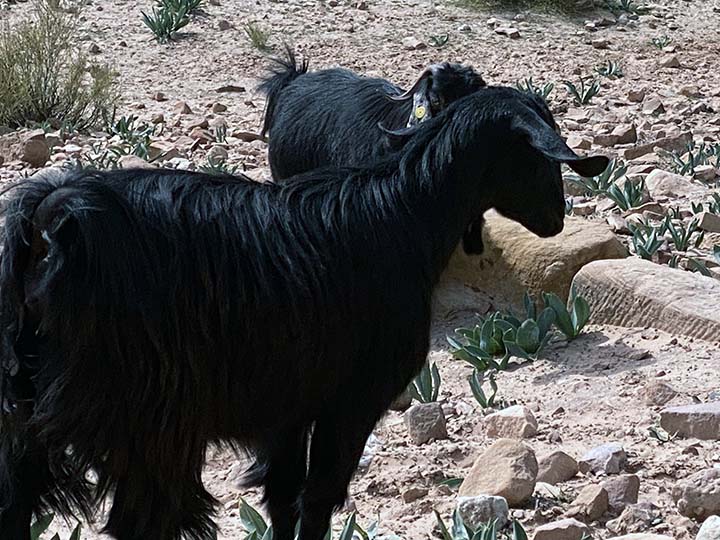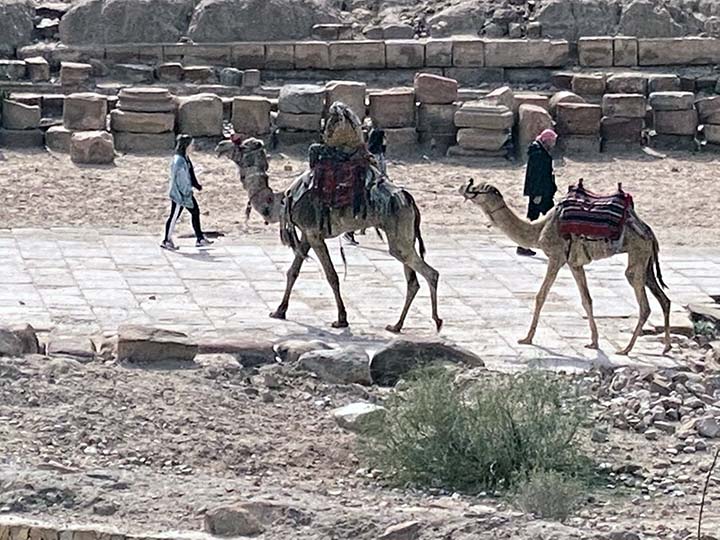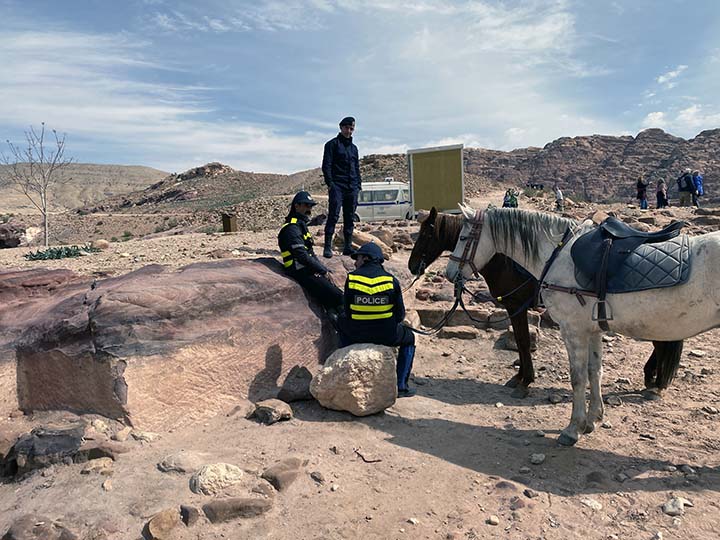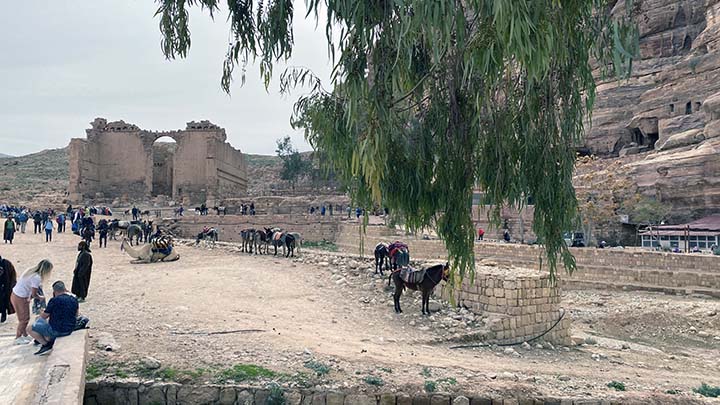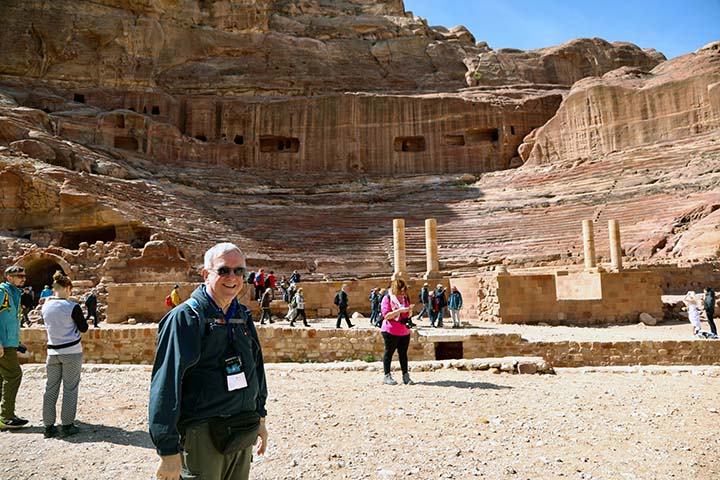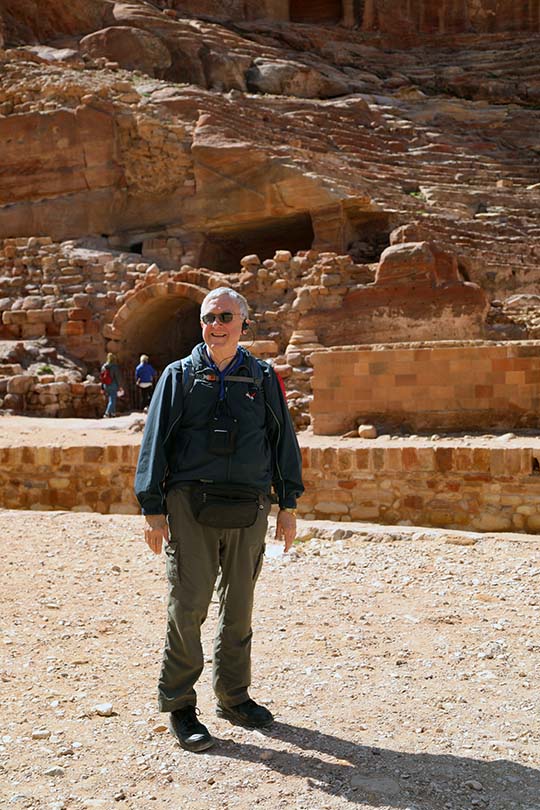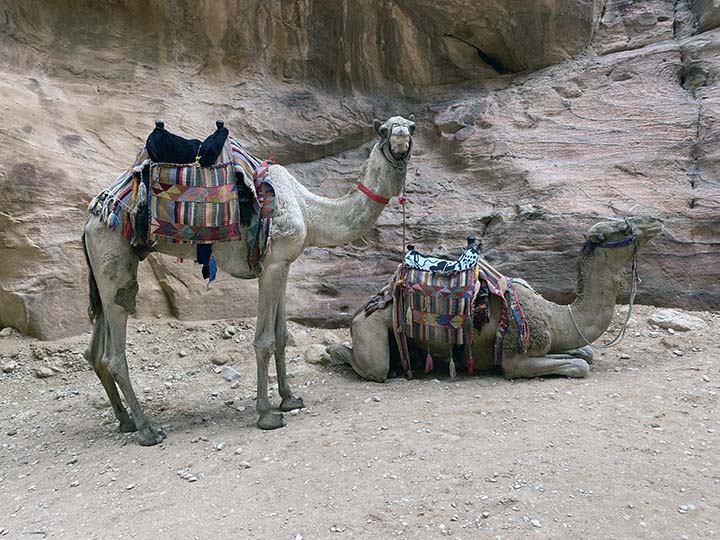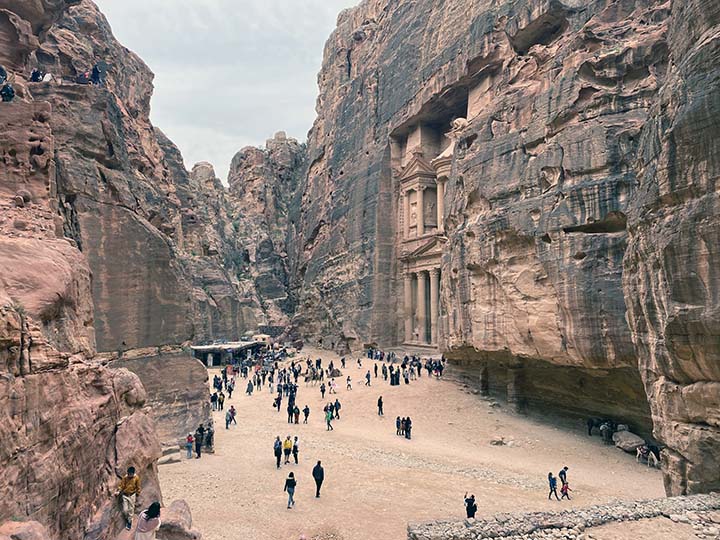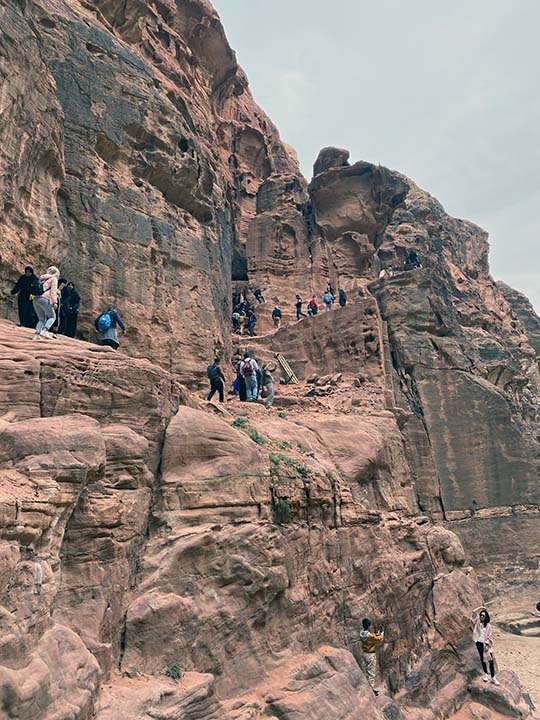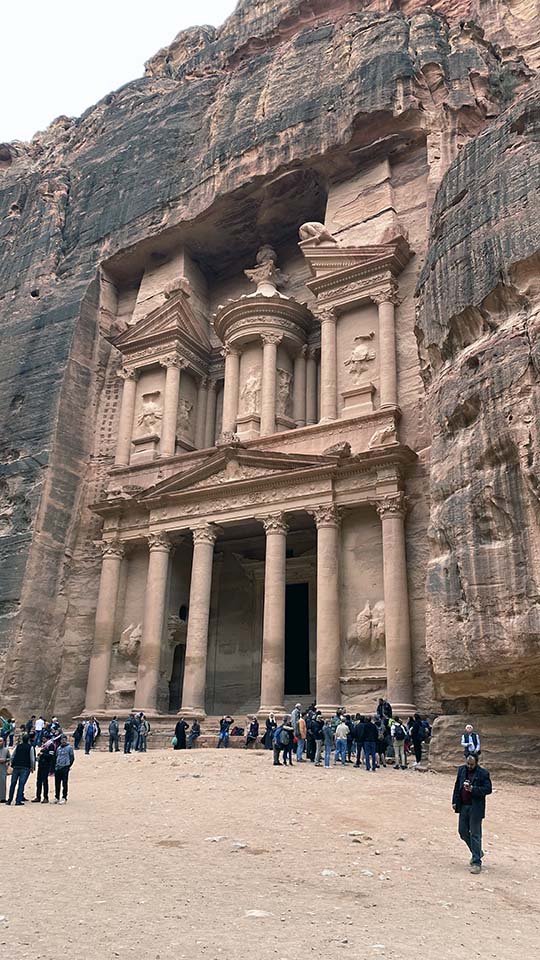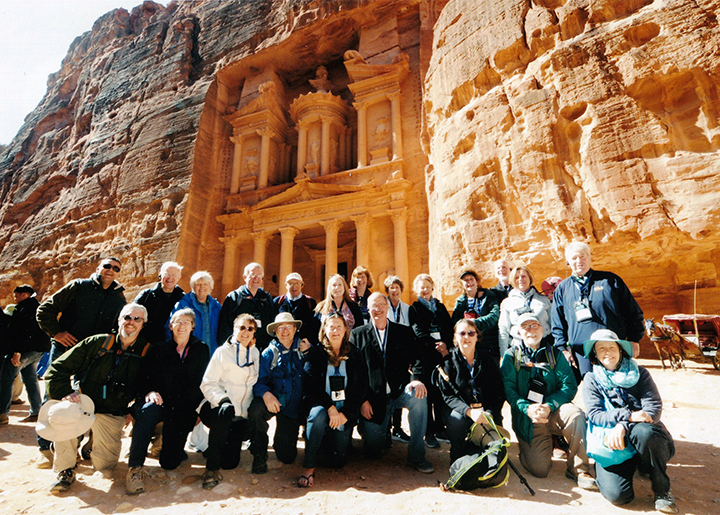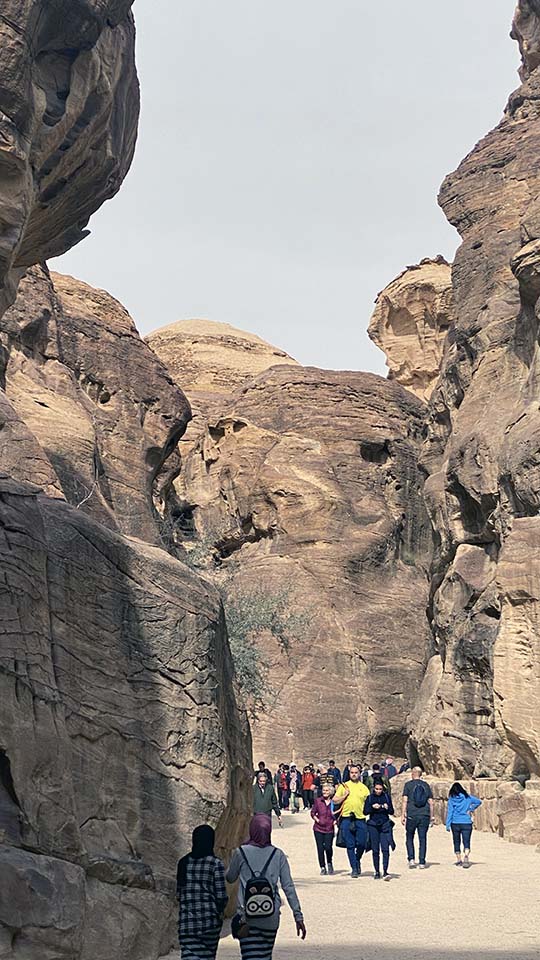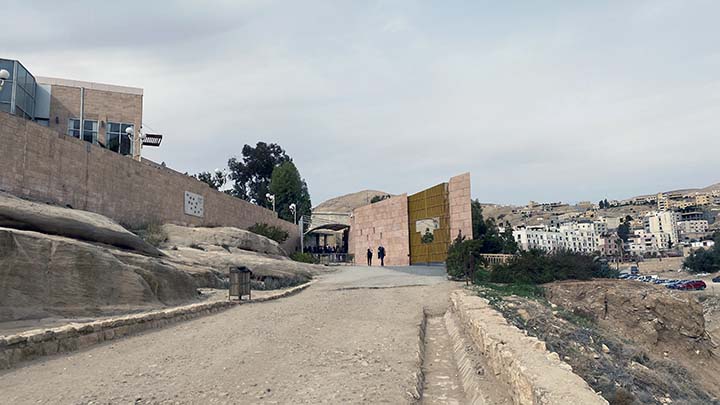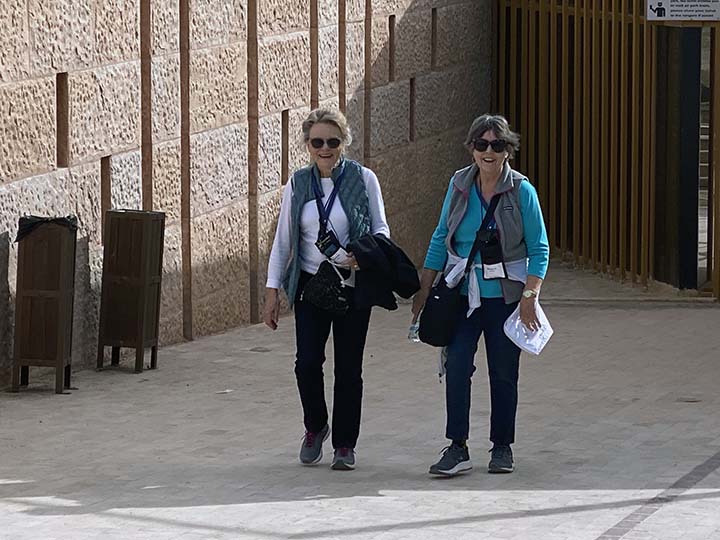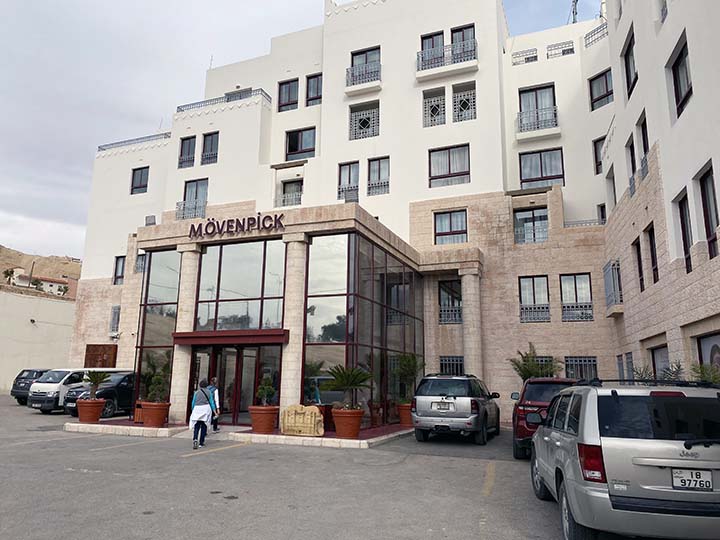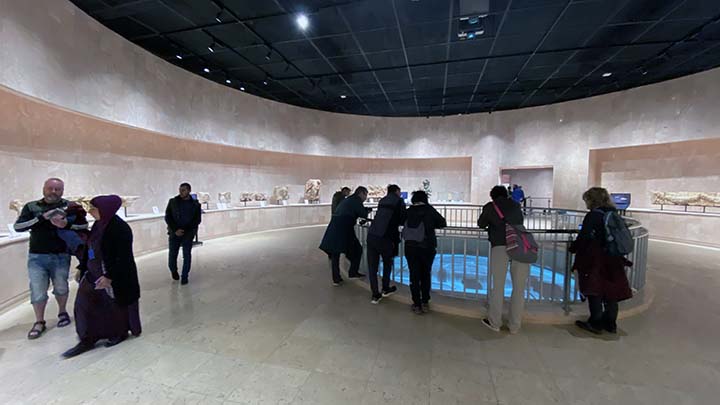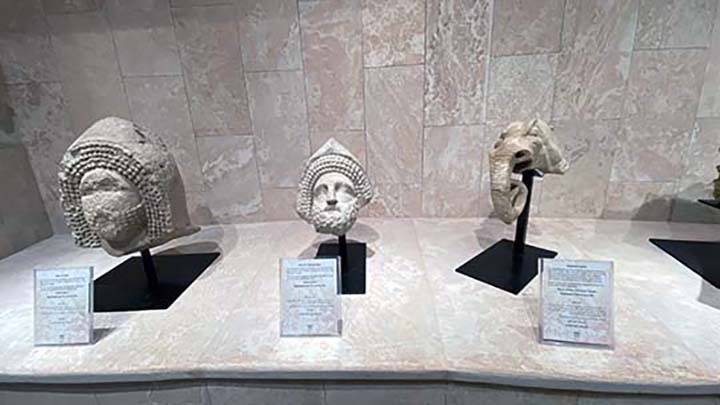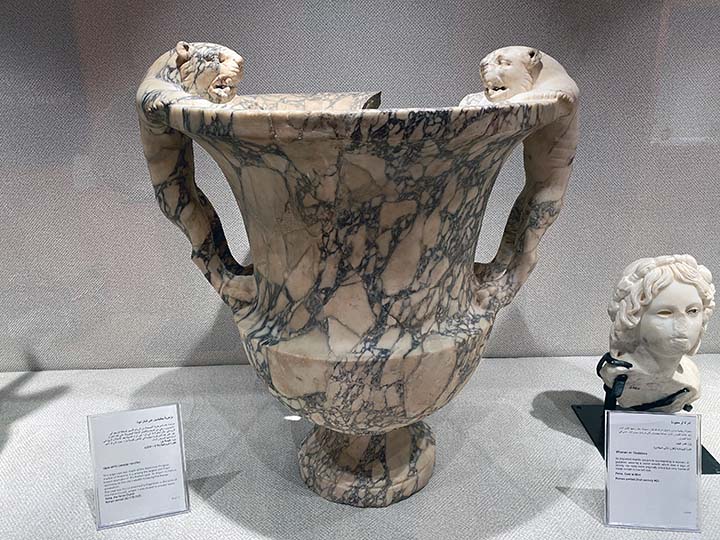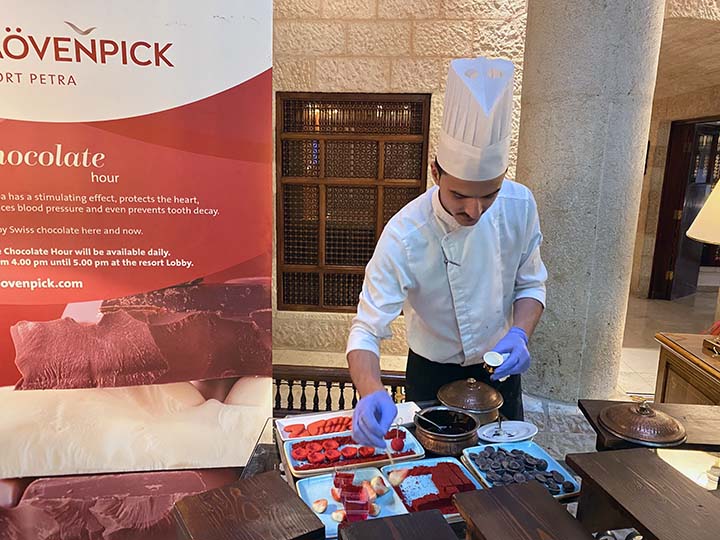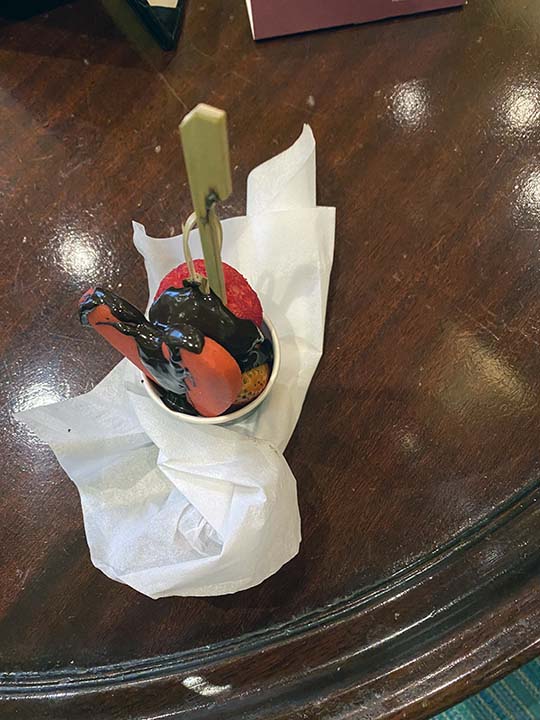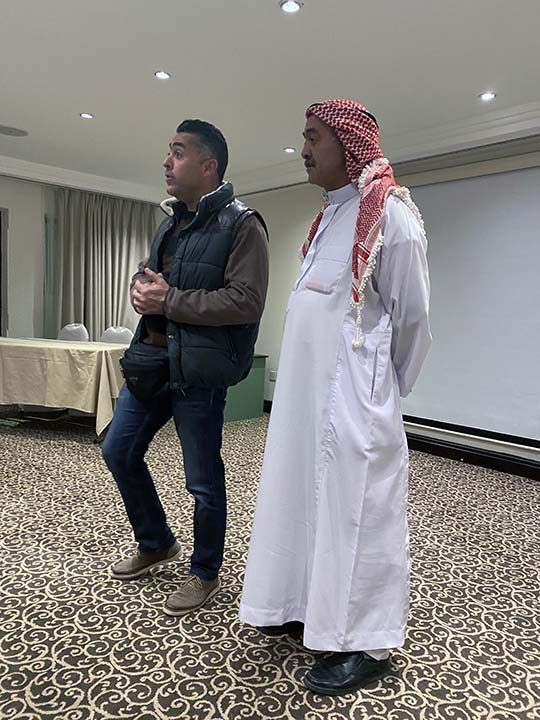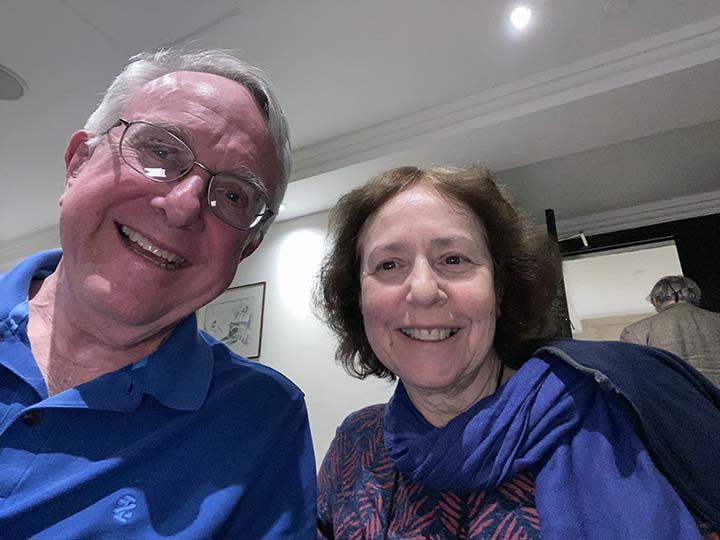|
Today we are visiting Petra, the famous Nabatean city carved in sandstone in Jordanís southwestern desert. Whatís a Nabatean, you ask? Stick with me here and learn something interesting.
The weather forecast said it would be a cloudy day. Pshaw. (I just noticed thereís an American flag in this picture. I have no idea why. Must be a display of flags from countries that have supported the place.)
Itís a place worth supporting because it is amazing, absolutely
amazing. That is a giant mausoleum carved into the sandstone rock of
the cliffs that lead into the ancient city of Petra. And whatís
Petra?
Petra was built about 300 BCE by the Nabateans, an Arab people who inhabited northern Arabia and the Southern Levant in antiquity. They were just one of several Arab tribes at the time, but they became wealthy through success in trade. Their loosely controlled trading network, which centered on strings of oases that they controlled, where agriculture was intensively practiced in limited areas, and on the routes that linked them, had no securely defined boundaries in the surrounding desert. They chose a remote, easily defended area to build their fabulous capital city of Petra. They maintained territorial independence from their emergence in the 4th century BC until Nabataea was conquered by Trajan in 106 AD, annexing it to the Roman Empire. Nabataeans' individual culture, easily identified by their characteristic finely potted painted ceramics, was adopted into the larger Greco-Roman culture. They were later converted to Christianity during the Byzantine Era. They have been described as ďone of the most gifted peoples of the ancient world".
So they were hugely successful at one time, but they got gobbled up by the Roman empire and you never hear about them anymore. Unless you visit Petra.
Mo is going to tell us all about it.
We have a long walk ahead of us.
No riding of donkeys for the Road Scholars.
The city is in the middle of nowhere, and it is protected by huge, sheer cliffs. To get there you have to do some serious walking. But before we really got started, Mo stopped us at a souvenir shop in order to let us see some genuine frankincense and myrrh. He figured we already knew what gold was.
Myrrh in his right hand, frankincense in his left. Frankincense is an aromatic resin used in incense and perfumes, obtained from trees. Frankincense is used in perfumery and aromatherapy. It is also an ingredient that is sometimes used in skincare.
Thatís myrrh up close. It is a natural gum or resin extracted from a number of small, thorny tree species. Myrrh resin has been used throughout history as a perfume, incense, and medicine. Myrrh gum is commonly claimed to remedy indigestion, ulcers, colds, cough, asthma, lung congestion, arthritis pain, and cancer. Maybe I should stock up while Iím here.
Moe gave me a little bit of frankincense to chew. It was waxy and it tasted like some sort of cleaning agent and it stuck to my teeth and itís now eight hours later and Iím still scraping bits of it out of my mouth. If anybody ever offers you some frankincense, donít eat it.
But if you burn it in a stone pot like this it smells really good.
OK, let's get started. Just look at the tourists in the buggy. Buncha weenies. The Road Scholars will walk, thank you very much.
This is not the Road Scholar way.
To get to Petra, you have to walk about 3/4 mile down through a canyon called ďal siq,Ē literally, ďthe shaft.Ē Yes, it is downhill all the way, and you are going to have to walk back up.
The walls of the siq can measure up to 26 stories tall.
They are astounding.
Tourists come from all over the world to experience this.
Big old rocks.
And a long walk.
There are interesting sights along the way.
Including Chinese tourists performing for their cameras.
Roman stones still make up part of the road.
And onward we go.
It's hard to watch your step on the uneven pavement when you're constantly looking up.
And on we go.
Everywhere there are carvings in the sandstone.
The Nabateans carved aqueducts into the walls of the siq to catch infrequent rain water as it ran down the sides of the cliffs.
Itís a pretty amazing walk, and tourists come from all over the world to see it.
And suddenly the siq gives way to the city of Petra.
Would you just look at that! Is it incredible or what? It is called Al-Khazneh, or ďthe Treasury.Ē Al-Khazneh was originally built as a mausoleum and crypt at the beginning of the 1st century AD during the reign of Aretas IV Philopatris. Its Arabic name Treasury derives from one legend that bandits or pirates hid their loot in a stone urn high on the second level. Significant damage from bullets can be seen on the urn. Local lore attributes this to Bedouins, who are said to have shot at the urn in the early 20th century, in hopes of breaking it open and spilling out the "treasure"óbut the decorative urn is in fact solid sandstone.
Famous for its rock-cut architecture and water conduit system, Petra is also called the 'Rose City' because of the color of the stone from which it is carved. It has been a UNESCO World Heritage Site since 1985. UNESCO has described Petra as "one of the most precious cultural properties of man's cultural heritage". In 2007, Al-Khazneh was voted one of the New7Wonders of the World. Petra is a symbol of Jordan, as well as Jordan's most-visited tourist attraction. Tourist numbers peaked at 918,000 in 2010, but there followed a temporary slump during the political instability generated by the Arab Spring, which affected countries surrounding Jordan. Visitor numbers subsequently increased and reached a record-breaking 1.1 million tourists in 2019, marking the first time that the figure rose above the 1 million mark. Tourism in the city was crippled by the COVID-19 pandemic as visitor numbers plummeted to zero since March 2020. The Jordanian government has authorized excavations in front of the treasury to make use of the site's emptiness.
The tourist read about this place in high school and has wanted to visit ever since.
Time has eroded a lot of the detail in the artwork.
Many of the building's architectural details have eroded away during the two thousand years since it was carved and sculpted from the cliff. The sculptures are thought to be those of various mythological figures associated with the afterlife. On top are figures of four eagles that would carry away the souls. The figures on the upper level are dancing Amazons with double-axes. The entrance is flanked by statues of the twins Castor and Pollux who lived partly on Olympus and partly in the underworld.
The carvers who built this place used these depressions to climb up and down.
The Treasury has appeared in many Hollywood films, gaining particular fame after being featured in climactic scenes in the popular 1989 film Indiana Jones and the Last Crusade, in which its facade is represented as the entrance to the final resting place of the Holy Grail. The interior scenes of the temple were filmed at Elstree Studios in England.
Thatís because there is no interior here. If you try to run into that room youíll look like Wile E. Coyote running smack into a big black wall.
It is impressive, but it is just a faÁade. Here's a hole just in front of the "entrance."
The real tombs were down below the front entrance.
What an incredible sight.
The camel, though, is unimpressed.
There are plenty of other faÁades in Petra. They probably represent the tombs of very important people. Not all of them are even finished; you can see the bare wall of an unfinished tomb.
Mo points out more carvings.
Letís go inside and see where somebody was buried.
Thereís room for three in here.
There are donkeys.
Those are camels.
And there are ruins.
Thatís part of a Royal Palace.
Thatís a kid on a donkey. There were lots of kids here today as in Jordan, Friday and Saturday are the days kids get off from school. They help the family make money when they can, by selling postcards and offering donkey rides to tourists.
The tourists mix with the Bedouins.
This tourist is taking it all in.
At this point I was beginning to think I'd like to have a donkey of my own to get around on.
Peek-a-boo Palace.
Iíve been reading this book about a New Zealand woman who came here as a tourist and ended up marrying a Bedouin who lived in a cave in Petra. Interesting read.
Itís a true story! There she is, a few years older, but it really is Marguerite van Geldermalsen.
She'll gladly sell you trinkets and even autographed copies of her book.
She was a charming lady.
That was her shop.
Let's move on; there are more ruins to see.
Thatís a palace. It is in worse shape than the treasury because it wasnít recessed into the side of the cliff as the treasury was.
I really would like to be able to see this place in its heyday.
All those plants are in the tulip family but they donít produce beautiful flowers, and animals donít like to eat them, so theyíre not good for much. Kinda like that tourist.
The tourist is intent on touristing.
Do you see the camel? I see the camel. Up there in the rocks. Really big guy. See him now?
Mo keeps explaining.
The Nabateans were wary of the earthquakes that happen not infrequently around here. This was the only building that survived the great earthquake of 363, and that was because it had been built with branches of juniper trees used as reinforcement.
Drimia maritima (syn. Urginea maritima) is a species of flowering plant in the family Asparagaceae, subfamily Scilloideae (formerly the family Hyacinthaceae). This species is known by several common names, including squill, sea squill, sea onion, and maritime squill. It may also be called red squill, particularly a form which produces red-tinged flowers instead of white. It is native to southern Europe, western Asia, and northern Africa.
This species has been used as a medicinal plant since ancient times. It is noted in the Ebers Papyrus of the 16th century BC, one of the oldest medical texts of ancient Egypt. Pythagoras wrote about it in the 6th century BC. Hippocrates used it to treat jaundice, convulsions, and asthma. Theophrastus was also familiar with it. Its primary medicinal use was as a treatment for edema, then called dropsy, because of the diuretic properties of the cardiac glycosides. A solution of sea squill and vinegar was a common remedy for centuries. The plant is also used as a laxative and an expectorant.
The plant has also been used as a poison. It is very bitter, so most animals avoid it. Rats, however, eat it readily, and then succumb to the toxic scilliroside. This has made the plant a popular rodenticide for nearly as long as it has been in use as a medicine.[4] The bulbs are dried and cut into chips, which can then be powdered and mixed with rat bait. The plant was introduced as an experimental agricultural crop in the 20th century primarily to develop high-toxicity varieties for use as rat poison. Interest continued to develop as rats became resistant to coumarin-based poisons. These guys are having nothing to do with it.
Those are camels.
Thatís a camel on a hill.
That's the police.
This has turned out to be an incredible day.
The tourist just can't get over it.
All those years ago back in the library at Whitehaven High School when he read Richard Halliburton's description of Petra...and now he's actually here. Holy moley.
The camels, though, are less impressed.
The tourists has found a place to climb up for a better view.
He's hoping he doesn't fall off the cliff and ruin this vacation.
Now it's time to say goodbye, likely forever, to this incredible world treasure.
Most of the Road Scholars gathered for a group photo.
And then we headed back up al siq.
Watch out for the Petra taxis!
Just like before, only this time it was uphill.
Ah, civilization.
They look like they had a good time!
The hotel was a welcome sight.
When I had climbed all the way back out of Petra, I was pooped. So I went to my room to rest a bit, and then walked across the street from the hotel to the Petra Archeological Museum. It wasnít an extensive museum with a huge number of artifacts, but what it had was presented very nicely. A good museum.
Artifacts. See?
Nice ones, too.
But the hotel beckoned.
I almost missed the hotel's afternoon chocolate experience.
But the nice chocolate chef put together a chocolate creation for me.
Our speaker for the evening, Mahmoud Twaissi, was a Bedouin who was born in a cave in Petra. His presentation was fascinating. Did you know that Bedouins make their tents out of yarn spun from goat hair instead of sheepĎs wool? Thatís because the goat hair yarn makes tent cloth with little holes that allow the walls to breathe when the temperature is hot, and when it rains the goat hair shrinks and seals up and becomes waterproof. Then when the rain stops and the cloth dries, it expands to its original condition. SheepĎs wool shrinks and stays shrunk, and thatís no good at all for a Bedouin. And now you know something you didnít know before.
We will have to say goodbye to our group leader Shari tomorrow when we fly to Egypt. She has been terrific and we will miss her.
|

